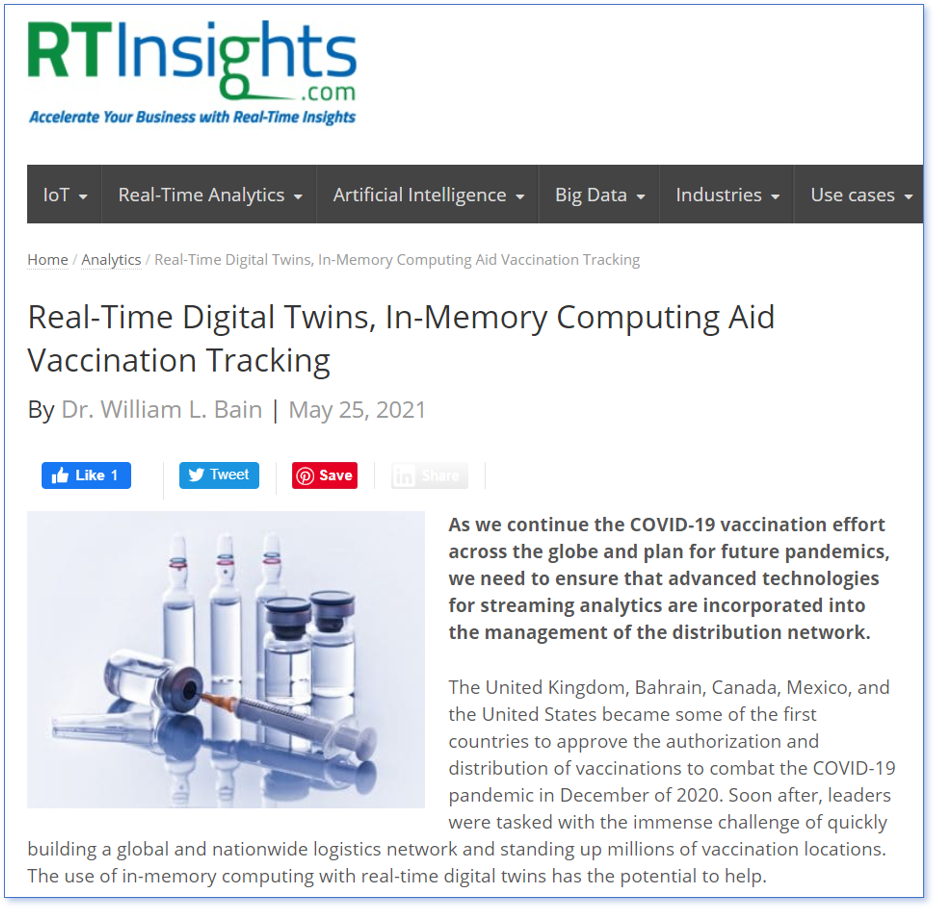The post Preventing Train Derailments Using Digital Twins appeared first on ScaleOut Software.
]]>
Using Digital Twins to Track and Simulate Large Systems
For decades, digital twins have played a crucial role in the field of product lifecycle management (PLM), where they assist in the design and testing of many types of devices, from valves to jet engines. ScaleOut Software has pioneered the use of digital twin technology combined with in-memory computing to track the behavior of live systems with many components – such as vehicle fleets, IoT devices, and even people – to monitor status in real time and boost situational awareness for operational managers.
Now, both data analysts and system managers can also harness the power of digital twins to simulate the behaviors of complex systems with thousands of interacting entities. Digital twin simulations can provide invaluable information about complex interactions that are otherwise difficult to study. They can explore scenarios often found in live systems, informing decisions and helping to identify potential issues in the planning phase. They also empower professionals to validate real-time analytics prior to deployment and to make predictions that help manage live systems.
A Case Study: Rail Transportation Safety
Consider an important use case in transportation safety for the U.S. freight railway system. The U.S moves more than 1.6 billion tons of freight over 140,000 miles of track each year. In 2022, there were 1,164 train derailments that caused damage measured in the millions of dollars and cost multiple lives. For example, in February 2023, fifty freight cars derailed in East Palestine, Ohio in a widely publicized accident. How can digital twins help prevent similar emergencies?
Currently, track-side sensors detect mechanical issues that can cause derailments, such as severely overheated wheel bearings, and radio train engineers often too late to prevent an accident. In the Ohio event, the NTSB preliminary report described increasing temperatures reported by three rail-side “hot box” detectors before the accident occurred. The U.S. railway network places these detectors every few miles across the country:

Example of a hot box detector (BBT609 – Own work, CC BY-SA 3.0, https://commons.wikimedia.org/w/index.php?curid=25975512)
Hot box detectors capture the data needed to track increasing wheel bearing temperatures and predict impending derailments. However, safety systems need to harness this data more effectively to prevent these incidents. Digital twins can help.
Real-time analytics using digital twins can combine temperature information from multiple hot boxes to detect anomalies and take action faster, before small problems escalate into derailments. Cloud-hosted analytics can simultaneously track the entire rail network’s rolling stock using a scalable, in-memory computing platform, such as the ScaleOut Digital Twin Streaming Service , to host digital twins. They can continuously analyze patterns of temperature changes for each car’s wheel bearings, combine this with known information about the rail car, such as its maintenance history, and then assess the likelihood of failure and alert personnel within milliseconds. This use of contextual information also helps prevent false-positive alerts that create costly delays.
, to host digital twins. They can continuously analyze patterns of temperature changes for each car’s wheel bearings, combine this with known information about the rail car, such as its maintenance history, and then assess the likelihood of failure and alert personnel within milliseconds. This use of contextual information also helps prevent false-positive alerts that create costly delays.
Using Digital Twin Simulations to Design and Test Real-Time Analytics
To help railway engineers develop and test new predictive analytics software, large-scale simulations can model the flow of information from the hundreds of thousands of freight cars that cross the U.S. each day, as well as the thousands of detectors placed along the tracks. These simulations can statistically simulate emerging wheel bearing issues to test how well real-time analytics software can detect impending failures before an accident occurs. Digital twins serve double duty here; they implement real-time analytics, and they model wheel bearing failures.
As a proof of concept, ScaleOut Software created a simulation of the U.S. freight rail system to evaluate how well digital twins can track wheel bearing temperatures from multiple hot box detectors and alert engineers to avoid derailments. The simulation runs as a discrete event simulation with digital twins exchanging messages in simulated time to model interactions.
Workload Generator
This workload generator creates 500-1000 simulated trains, each with 100 freight cars and 8 wheel bearings per car. The simulated trains travel on a hypothetical rail map that crisscrosses a hypothetical U.S. rail map with 107 routes between major U.S. cities:

The simulated rail network places 3,800 hot box detectors approximately every 10 miles along the tracks. Each detector’s job is to report the wheel bearing temperatures for every freight car as a train passes it along the route, just as a real hot box detector would.
The simulation uses a separate digital twin model to implement trains and hot box detectors. (Each digital twin model has its own properties and algorithms.) A simulated train keeps track of its route, current position, speed, and freight cars. It also implements a probabilistic model of wheel bearing failures that cause a wheel bearing to enter a deteriorating state with a probability of 1:1M and then increase its temperature over time. As it passes a simulated detector, each train reports the temperature of all wheel bearings to the detector. After a deteriorating wheel bearing passes ten detectors, it increases to a 1:4 probability of entering a failed state with a rapid temperature rise. Once a bearing reaches 500 degrees Fahrenheit, the model considers it to have experienced a catastrophic failure, which corresponds to a fire or derailment.
Here is an example of a wheel bearing’s temperature profile as it passes detectors along the rails:
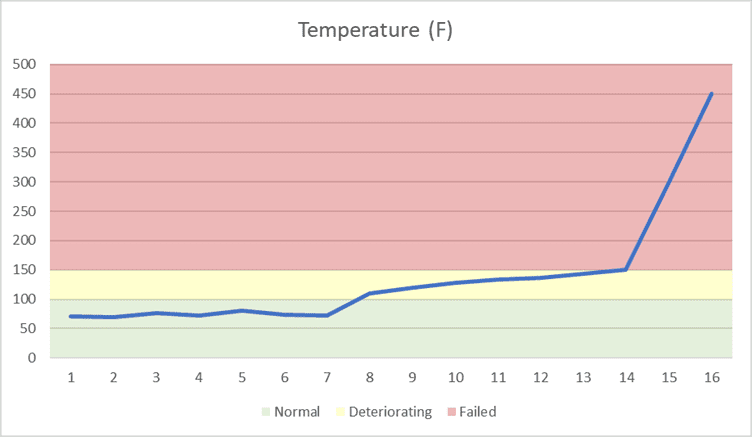
As simulated trains pass hot box detectors and report their wheel bearing temperatures, the detectors send a message to their corresponding real-time digital twins, which capture and analyze this telemetry.
The following diagram shows the simulation’s workload generator made up of digital twins:

Real-Time Analytics
Digital twins also implement real-time analytics code for detecting wheel bearing failures. Once deployed in a data center for production use, they continuously track telemetry from real hot box detectors to look for possible wheel bearing failures and alert train engineers. In an actual deployment, existing hot box detectors would send messages over the cellular phone system to a cloud-based analytics service instead of just making radio broadcasts to nearby train personnel.
The analytics code uses two digital twin models, one for hot box detectors and another for individual train cars. The hot box detector twins receive telemetry messages from corresponding physical hot boxes along the tracks. Digital twins of train cars track telemetry and other relevant information about all the wheel bearings on each car. They build a picture over time of trends in wheel bearing temperatures reported by multiple detectors. They also can combine a temperature history with other contextual information, such as the type of wheel bearing and its service history, to best decide when a failure might be imminent.
In the simulation, train car digital twins just keep temperature histories for all wheel bearings and look for an upward trend over time. If a digital twin detects a potentially dangerous trend, it sends a message back to the simulated train, instructing it to stop.
To run the simulation, the workload generator sends messages to the real-time analytics:
The same analytics twins can receive telemetry from actual hot box detectors after deployment:
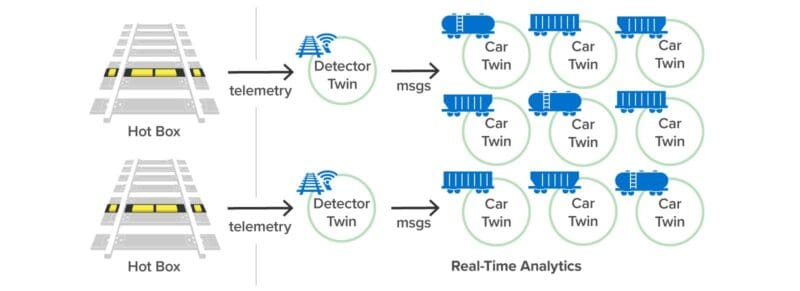
Simulation Results
The simulation divides the U.S. rail network into regions. To check that trend analysis is working, we disable it in the south and southwest and compare it to other regions. The simulation shows that trend analysis catches all deteriorating bearings before they fail and cause derailments. Derailments only occur on routes not performing trend analysis.
The ScaleOut Digital Twin Streaming Service provides tools to visualize these results. The following dashboard widgets track the number of alerted trains by region that are undergoing inspection (because trend analysis detects an issue) along with the number of derailed trains. Note that derailments only occur in the regions with trend analysis disabled:
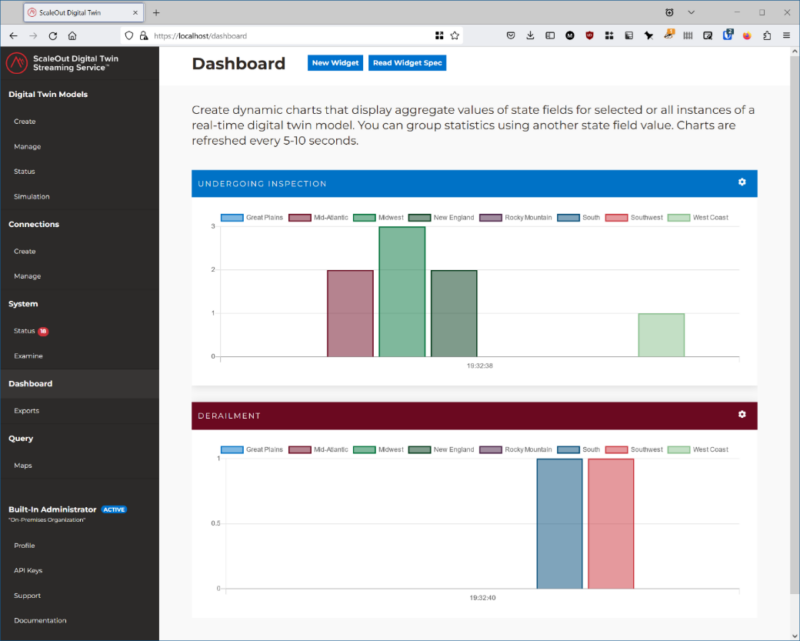
The following geospatial map of a continuous query shows the trains which are running normally in green, undergoing inspection in blue, and derailed in red. This map confirms that all derailed trains are located in the south and southwest regions and shows trains undergoing inspection in other regions:

Summing Up
The U.S. freight railways provide the backbone of the country’s freight transport system and must run with minimum disruptions. New technology like digital twins can take advantage of existing infrastructure to provide continuous monitoring that is missing today. Using scalable in-memory computing, digital twins can capture live telemetry throughout the rail system, analyze it in context, and create immediate alerts when needed. They can also implement simulations to model these issues and help planners evaluate real-time analytics software.
Beyond just watching wheel bearings, digital twins can track other areas of the rail system, such as rail intersections and switches, to further boost safety. With this technology, digital twins can help build next-generation safety systems to eliminate dangerous and costly derailments.
The post Preventing Train Derailments Using Digital Twins appeared first on ScaleOut Software.
]]>The post CEO William Bain Gives Talk for the Digital Twin Consortium appeared first on ScaleOut Software.
]]>In this talk, Dr. Bain described a new vision for digital twins that takes them beyond traditional applications to address challenges faced by managers of large systems with thousands or even millions of data sources. Digital twins can implement streaming analytics that continuously monitor these complex systems for emerging issues and help managers boost their situational awareness.
Numerous applications can benefit from this new use of digital twins. Examples described in the talk include tracking vehicle fleets and logistics networks, improving the safety of transportation systems, and assisting in disaster recovery.
ScaleOut Software’s in-memory computing technology makes it possible to simultaneously host thousands of digital twins and run both streaming analytics and simulations. The talk explains how this technology adds real-time aggregate analytics while lowering response times and scaling performance.
Download The Presentation Slides
- Learn more about the ScaleOut Digital Twin Streaming Service
 .
. - Watch Dr. Bain’s previous digital twin talk.
The post CEO William Bain Gives Talk for the Digital Twin Consortium appeared first on ScaleOut Software.
]]>The post New Digital Twin Features for Real-World Applications appeared first on ScaleOut Software.
]]>
Using Digital Twins for Streaming Analytics
In the two years since we initially released the ScaleOut Digital Twin Streaming Service , we have applied the digital twin model to numerous use cases, including security alerting, telematics, contact tracing, logistics, device tracking, industrial sensor monitoring, cloned license plate detection, and airline system tracking. Constructing applications for these use cases has demonstrated the power of the digital twin model in creating streaming analytics that track large numbers of data sources.
, we have applied the digital twin model to numerous use cases, including security alerting, telematics, contact tracing, logistics, device tracking, industrial sensor monitoring, cloned license plate detection, and airline system tracking. Constructing applications for these use cases has demonstrated the power of the digital twin model in creating streaming analytics that track large numbers of data sources.
The process of building digital twin applications allowed us to surface both the strengths and shortcomings of our APIs. This has led to a series of new features which enhance the core platform. For example, we created a rules engine for implementing the logic within a digital twin so that new models can be created without the need for programming expertise. We then added machine learning to digital twin models using Microsoft’s ML.NET library. This enables digital twins to look for patterns in telemetry that are difficult to define with code. More recently, we integrated our digital twin model with Microsoft’s Azure Digital Twins to accelerate real-time processing using our in-memory computing technology while providing new visualization and persistence capabilities for digital twins.
With the newly announced version 2, we are adding important new capabilities for real-time analytics to our digital twin APIs. Let’s take a look at some of these new features.
New Support for .NET 6
Version 2 expands the target platforms for C#-based digital twin models by supporting .NET 6. With our goal to make the ScaleOut Digital Twin Streaming Service’s feature set and visualization tools uniformly available in the cloud and on-premises, we recognized that we needed to move beyond support for .NET Framework, which can only be deployed on Windows. By adding .NET 6, we can take advantage of its portability across both Windows and Linux. Now C#, Java, JavaScript, and rules-based digital twin models can be deployed on all platforms:
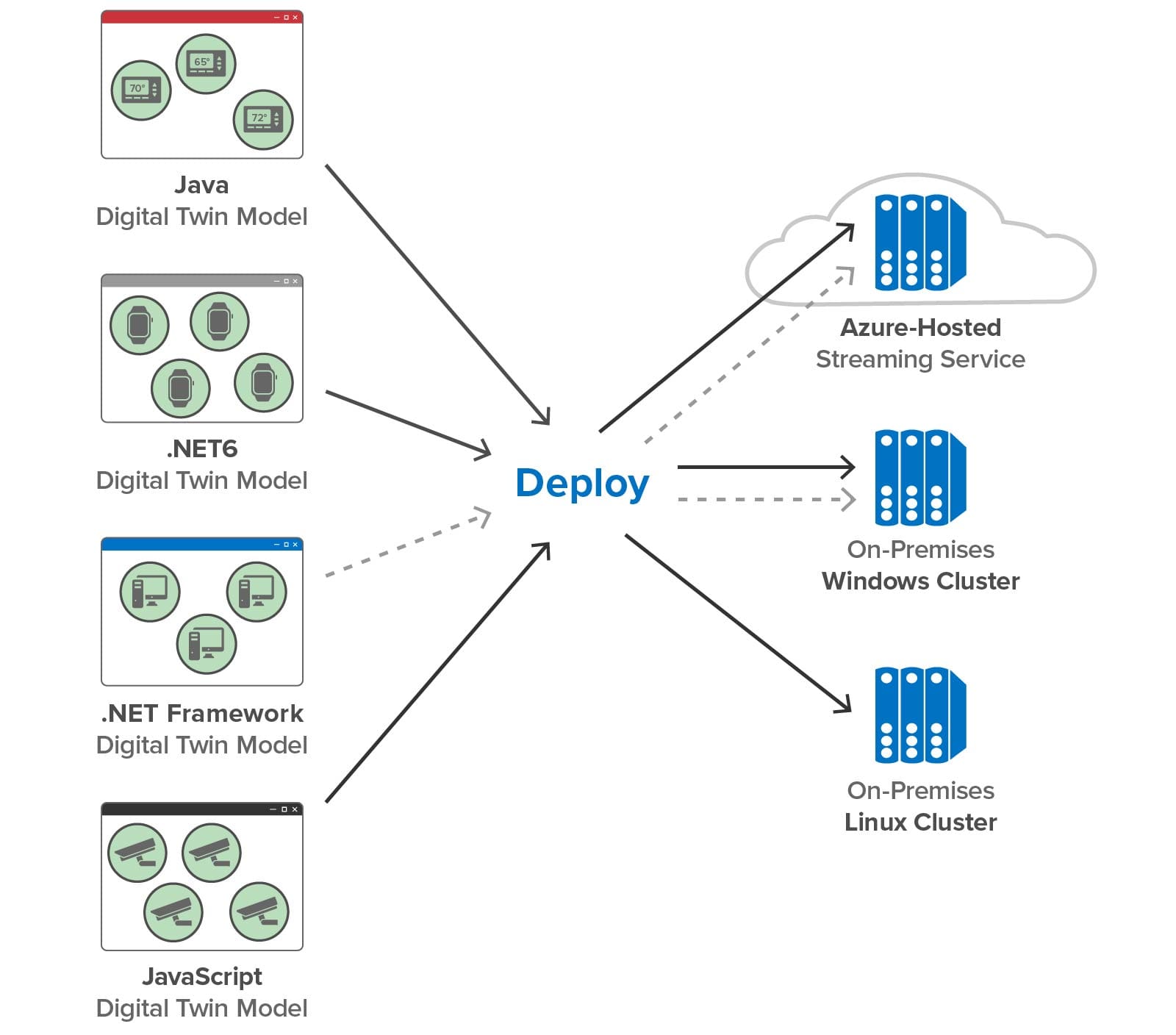
(As illustrated with the dotted lines above, we continue to support .NET Framework on Windows and in the Azure cloud.)
To take maximum advantage of .NET 6, we also re-implemented our Azure cloud service and key portions of the back-end infrastructure in .NET 6. This provides better performance and flexibility for future upgrades.
Digital Twin Timers
Using our APIs, digital twins can run analytics code to process incoming messages from their corresponding data sources. In developing a proof-of-concept application for an industrial safety application, we learned that they also need to be able to create timers and run code when the timers expire. This enables digital twins to detect when their data sources fail or become erratic in sending messages.
For example, consider a digital application that tracks periodic telemetry from a collection of building thermostats. Each digital twin looks for abnormal temperature excursions that indicate the need to alert personnel. In addition, a digital twin must determine if its thermostat has failed and is no longer sending periodic temperature readings. By setting a timer and restarting it after each message is received, the digital twin can signal an alert if excessive time elapses between incoming messages:

In the actual industrial safety application we built, buildings throughout a site had numerous smoke and gas sensors. Digital twins for the sensors incorporated timers to detect failed sensors. As shown below, they periodically forwarded their status to a hierarchy of digital twins arranged as shown below from the lowest level upwards. The digital twins represented floors within buildings, buildings within a site, sites within the organization, and the overall organization itself. At each level, status information was aggregated to gives personnel immediate information about where problems were occurring. The role of timers was critical in maintaining a complete picture of the organization’s status.

Aggregate Initialization
When we first implemented our digital twin platform, we designed it to automatically create a digital twin instance when the first message from an unknown data source arrives. (The platform determines which type of digital twin to create from the message’s contents.) This technique simplifies deployment by avoiding the need to explicitly create digital twin instances. The user simply develops and deploys a digital twin model, for example, for a gas sensor, and the platform creates a digital twin for each sensor that sends a message to the platform.
In many cases, it’s useful to create digital twin instances when deploying a model instead of waiting for messages to arrive. For example, both demo applications and simulations need to explicitly create digital twins since there are no actual physical devices. Also, applications with model hierarchies (like the example above) may need to create instances to fill out the hierarchy and start reporting at deployment time.
To address these needs, version 2 lets users supply a csv file when deploying a digital twin model. This csv file lists all digital twin instances and the initial values for each instance’s properties. The platform then creates the corresponding digital twin instances and sets the initial values.
Here’s an example that shows how a csv file generated from a spreadsheet can be deployed to the streaming service via the UI to initialize five digital twin instances. Note that the spreadsheet’s first row has the names of the properties to be set:
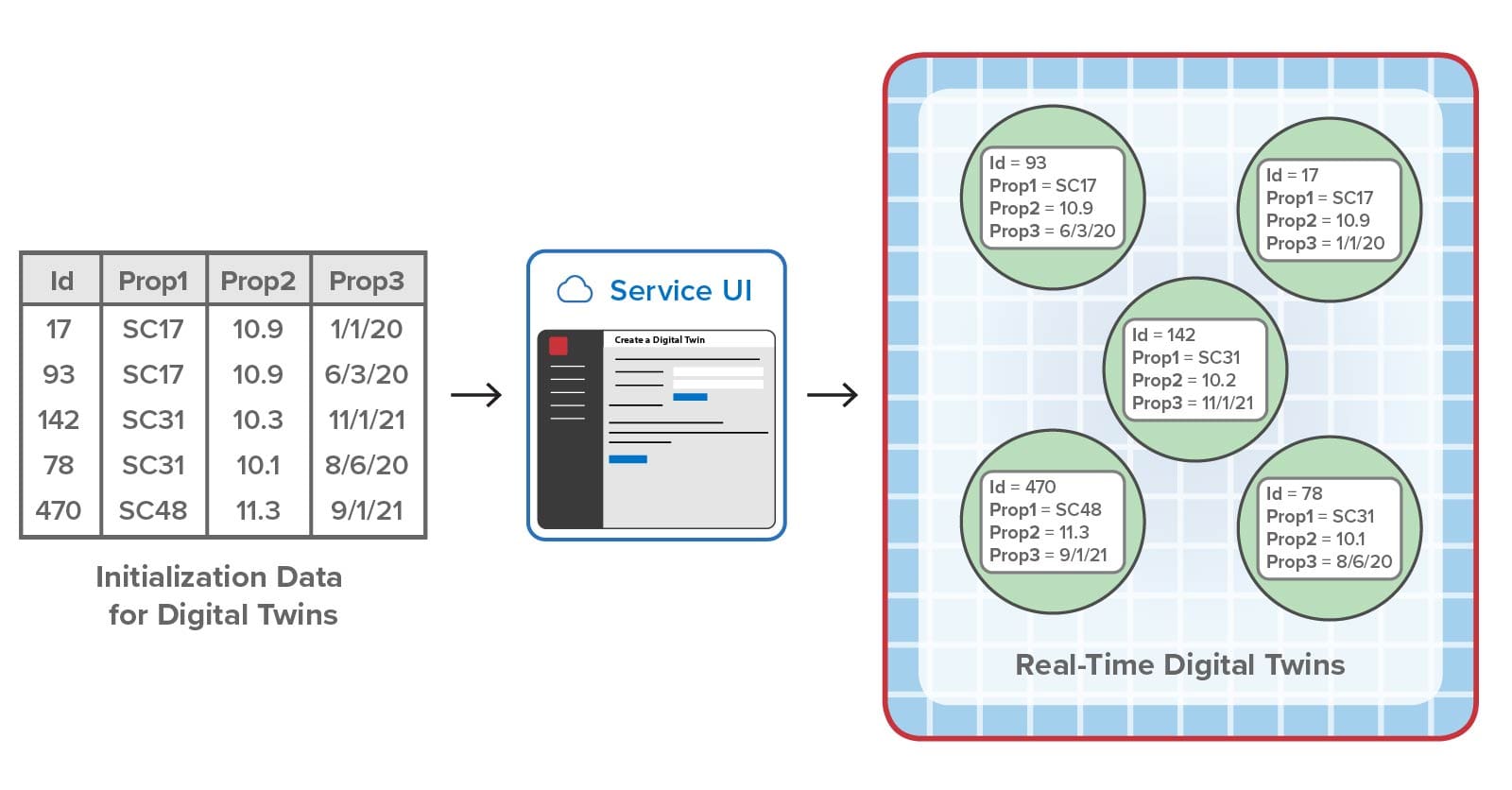
Summing Up
After more than two years of experience in building real-world applications with digital twins, we have confirmed the power of using digital twins for streaming analytics. Because digital twins bring together state information, telemetry, and application logic for each physical device, they enable deep introspection that tracks behavior and surfaces issues using a simple, highly efficient programming model. They also allow applications to focus on analytics code and defer the challenges of data visualization and throughput scaling to the streaming service.
With version 2, we have added important new capabilities to our implementation of the digital twin model and to the underlying platform. These features have been driven by emerging requirements that surfaced during application development. This matches our design philosophy of starting with a simple, coherent model and carefully enhancing it as new learnings are made.
Interestingly, our development work has consistently shown the value of using simulation to demonstrate the capabilities of the digital twin model for streaming analytics. The new features in version 2 enhance our ability to build simulations, and we expect to add more support for simulation in upcoming releases. Stay tuned.
The post New Digital Twin Features for Real-World Applications appeared first on ScaleOut Software.
]]>The post New Video Interview by the Digital Twin Consortium appeared first on ScaleOut Software.
]]>In this video, Bill explains how digital twins can make use of object-oriented programming techniques and in-memory computing to implement real-time analytics at scale. These combined technologies can enable a wide range of live applications to track thousands of data sources, identify issues, and respond in the moment. Target applications include IoT, telematics, logistics, disaster management, health-device tracking, energy management, cyber and physical security, and fraud detection.
ScaleOut Software offers an in-memory, digital twin platform designed to provide real-time analytics for applications with many data sources. The ScaleOut Digital Twin Streaming Service runs as an Azure-based cloud service and on-premises for developing and running object-oriented digital twin models written in C#, Java, and JavaScript. It includes a comprehensive UI for managing digital twins, aggregating and querying their dynamic state, and visualizing real-time trends.
runs as an Azure-based cloud service and on-premises for developing and running object-oriented digital twin models written in C#, Java, and JavaScript. It includes a comprehensive UI for managing digital twins, aggregating and querying their dynamic state, and visualizing real-time trends.
The post New Video Interview by the Digital Twin Consortium appeared first on ScaleOut Software.
]]>The post Unlocking New Capabilities for Azure Digital Twins with Real-Time Analytics appeared first on ScaleOut Software.
]]>
The Need for Real-Time Analytics with Digital Twins
In countless applications that track live systems, real-time analytics plays a key role in identifying problems (or finding opportunities) and responding fast enough to make a difference. Consider a software telematics application that tracks a nationwide fleet of trucks to ensure timely deliveries. Dispatchers receive telemetry from trucks every few seconds detailing location, speed, lateral acceleration, engine parameters, and cargo viability. In a classic needle-and-haystack scenario, dispatchers must continuously sift through telemetry from thousands of trucks to spot issues, such as lost or fatigued drivers, engines requiring maintenance, or unreliable cargo refrigeration. They must intervene quickly to keep the supply chain running smoothly. Real-time analytics can help dispatchers tackle this seemingly impossible task by automatically sifting through telemetry as it arrives, analyzing it for anomalies needing attention, and alerting dispatchers when conditions warrant.
By using a process of divide and conquer, digital twins can dramatically simplify the construction of applications that implement real-time analytics for telematics or other applications. A digital twin for each truck can track that truck’s parameters (for example, maintenance and driver history) and its dynamic state (location, speed, engine and cargo condition, etc.). The digital twin can analyze telemetry from the truck to update this state information and generate alerts when needed. It can encapsulate analytics code or use machine learning techniques to look for anomalies. Running simultaneously, thousands of digital twins can track all the trucks in a fleet to keep dispatchers informed while reducing their workload.
Applying the digital twin model to real-time analytics expands its range of uses from its traditional home in product lifecycle management and infrastructure tracking to managing time-critical, live systems with many data sources. Examples include preventive maintenance, health-device tracking, logistics, physical and cyber security, IoT for smart cities, ecommerce shopping, financial services, and many others. But how can we integrate real-time analytics with digital twins and ensure high performance combined with straightforward application development?
Message Processing with Azure Digital Twins
Microsoft’s Azure Digital Twins provides a compelling platform for creating digital twin models with a rich set of features for describing their contents, including properties, components, inheritance, and more. The Azure Digital Twins Explorer GUI tool lets users view digital twin models and instances, as well as their relationships.
Azure digital twins can host dynamic properties that track the current state of physical data sources. Users can create serverless functions using Azure Functions to ingest messages generated by data sources and delivered to digital twins via Azure IoT Hub (or other message hubs). These functions update the properties of Azure digital twins using APIs provided for this purpose. Here’s a redrawn tutorial example that shows how Azure functions can process messages from a thermostat and update both its digital twin and a parent digital twin that models the room in which the thermostat is located. Note that the first Azure function’s update triggers the Azure Event Grid to run a second function that updates the room’s property:
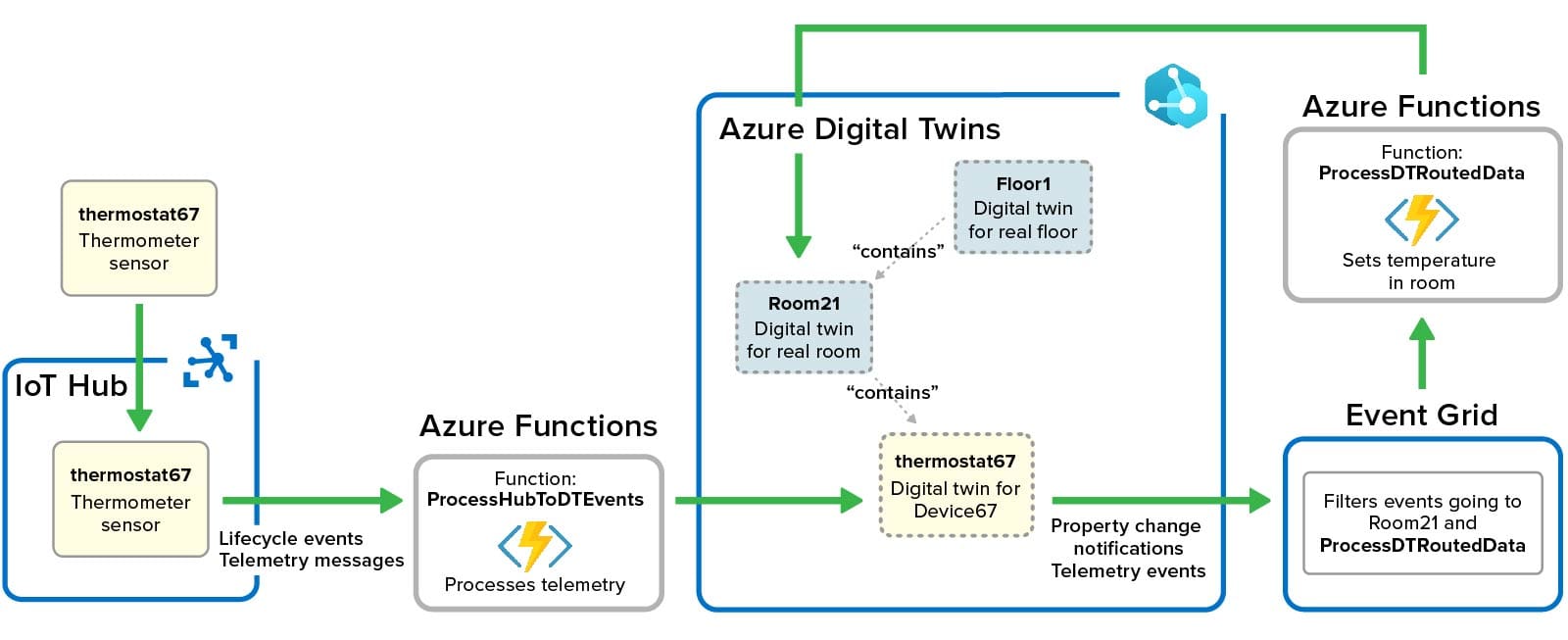
The challenge in using serverless functions to process messages and perform real-time analytics is that they add overhead and complexity. By their nature, serverless functions are stateless and must obtain their state from external services; this adds latency. In addition, they are subject to scheduling and authentication overheads on each invocation, and this adds delays that limit scalability. The use of multiple serverless functions and associated mechanisms, such as Event Grid topics and routes, also adds complexity in developing analytics code.
Adding Real-Time Analytics Using In-Memory Computing
Integrating an in-memory computing platform with the Azure Digital Twins infrastructure addresses both of the challenges. This technology runs on a cluster of virtual servers and hosts application-defined software objects in memory for fast access along with a software-based compute engine that can run application-defined methods with extremely low latency. By storing each Azure digital twin instance’s properties in memory and routing incoming messages to an in-memory method for processing, both latency and complexity can be dramatically reduced, and real-time analytics can be scaled to handle thousands or even millions of data sources.
ScaleOut Software’s newly announced Azure Digital Twins Integration does just this. It integrates the ScaleOut Digital Twin Streaming Service , an in-memory computing platform running on Microsoft Azure (or on premises), with the Azure Digital Twins service to provide real-time streaming analytics. It accelerates message processing using in-memory computing to ensure fast, scalable performance while simultaneously streamlining the programming model.
, an in-memory computing platform running on Microsoft Azure (or on premises), with the Azure Digital Twins service to provide real-time streaming analytics. It accelerates message processing using in-memory computing to ensure fast, scalable performance while simultaneously streamlining the programming model.
The ScaleOut Azure Digital Twins Integration creates a component within an Azure Digital Twin model in which it hosts “real-time” properties for each digital twin instance of the model. These properties track dynamic changes to the instance’s physical data source and provide context for real-time analytics.
To implement real-time analytics code, application developers create a message-processing method for an Azure digital twin model. This method can be written in C# or Java, using an intuitive rules-based language, or by configuring machine learning (ML) algorithms implemented by Microsoft’s ML.NET library. It makes use of each instance’s real-time properties, which it stores in a memory-based object called a real-time digital twin, and the in-memory compute engine automatically persists these properties in the Azure digital twin instance.
Here’s a diagram that illustrates how real-time digital twins integrate with Azure digital twins to provide real-time streaming analytics:
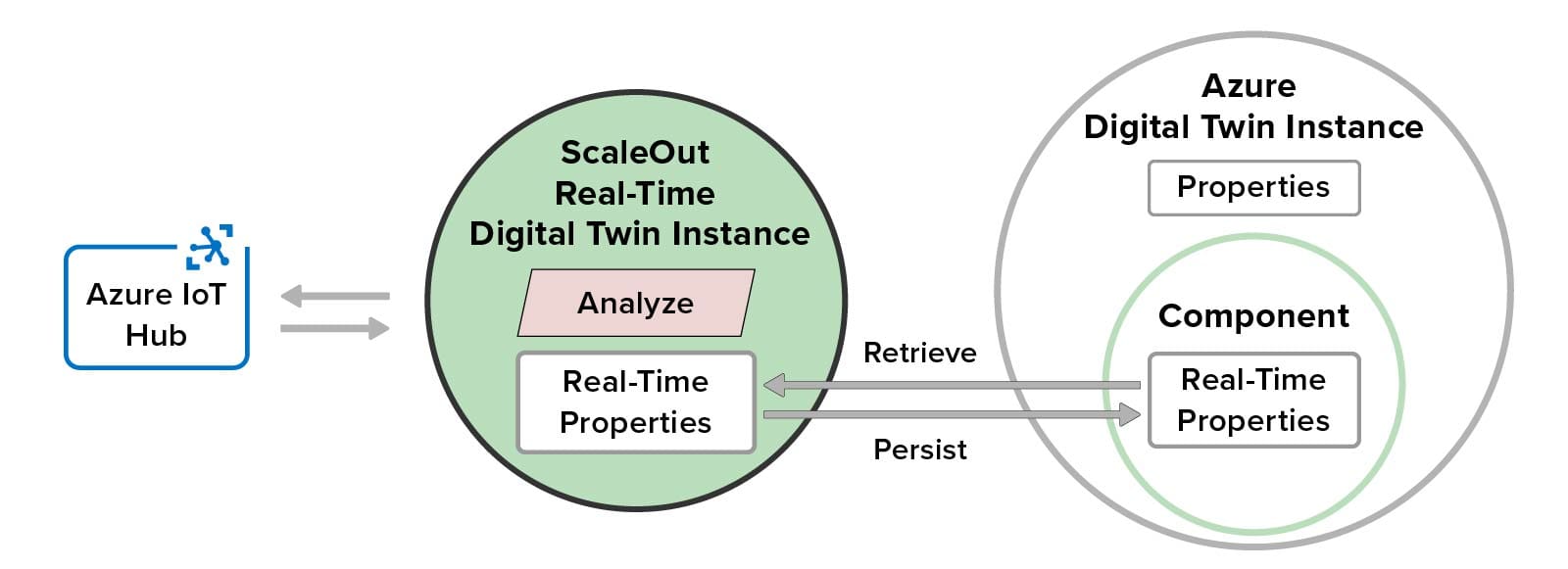
This diagram shows how each real-time digital twin instance maintains in-memory properties, which it retrieves when deployed, and automatically persists these properties in its corresponding Azure digital twin instance. The real-time digital twin connects to Azure IoT Hub or other message source to receive and then analyze incoming messages from its corresponding data source. Fast, in-memory processing provides sub-millisecond access to real-time properties and completes message processing with minimal latency. It also avoids repeated authentication delays every time a message is processed by authenticating once with the Azure Digital Twins service at startup.
All real-time analytics performed during message processing can run within a single in-memory method that has full access to the digital twin instance’s properties. This code also can access and update properties in other Azure digital twin instances. These features simplify design by avoiding the need to split functionality across multiple serverless functions and by providing a straightforward, object-oriented design framework with advanced, built-in capabilities, such as ML.
To further accelerate development, ScaleOut provides tools that automatically generate Azure digital twin model definitions for real-time properties. These model definitions can be used either to create new digital twin models or to add a real-time component to an existing model. Users just need to upload the model definitions to the Azure Digital Twins service.
Here’s how the tutorial example for the thermostat would be implemented using ScaleOut’s Azure Digital Twins Integration:
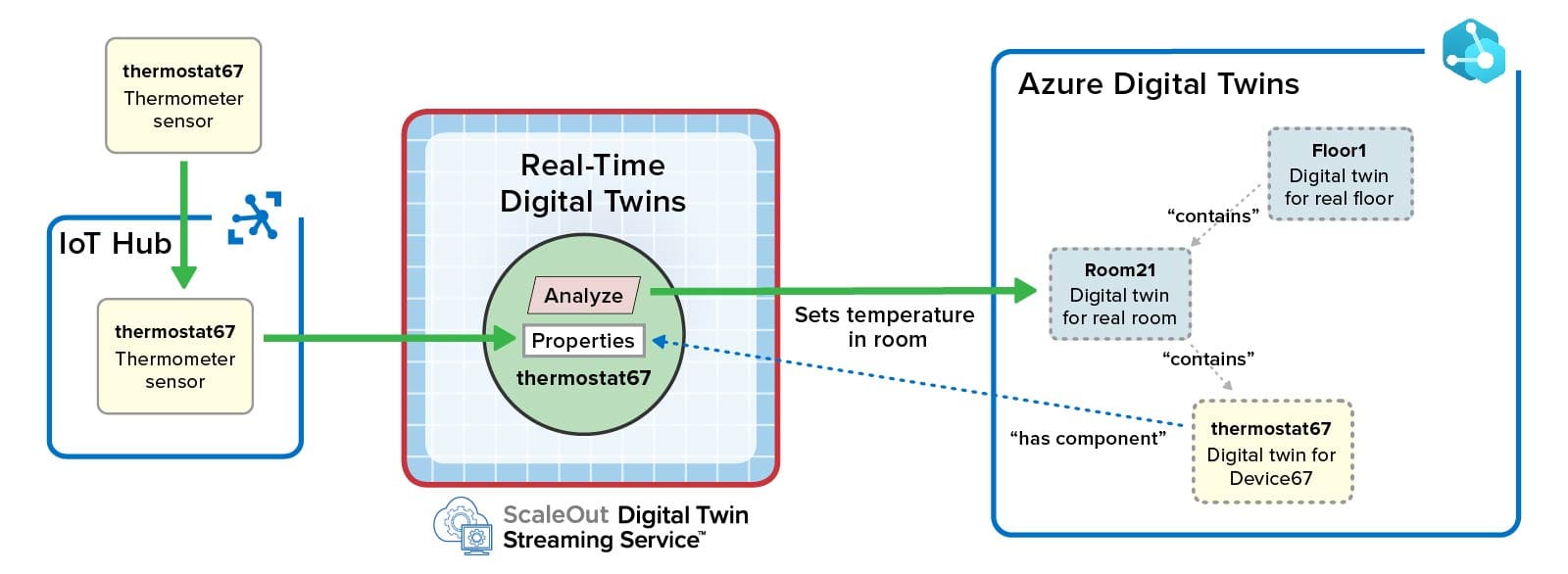 Note that the ScaleOut Digital Twins Streaming Service takes responsibility for ingesting messages from Azure IoT Hub and for invoking analytics code for the data source’s incoming messages. Multiple, pipelined connections with Azure IoT Hub ensure high throughput. Also note that the two serverless functions and use of Event Grid have been eliminated since the in-memory method handles both message processing and updates to the parent object (Room 21).
Note that the ScaleOut Digital Twins Streaming Service takes responsibility for ingesting messages from Azure IoT Hub and for invoking analytics code for the data source’s incoming messages. Multiple, pipelined connections with Azure IoT Hub ensure high throughput. Also note that the two serverless functions and use of Event Grid have been eliminated since the in-memory method handles both message processing and updates to the parent object (Room 21).
Combining the ScaleOut Digital Twin Streaming Service with Azure Digital Twins gives users the power of in-memory computing for real-time analytics while leveraging the full spectrum of Azure services and tools, as illustrated below for the thermostat example:

Users can view real-time properties with the Azure Digital Twins Explorer tool and track changes due to message processing. They also can take advantage of Azure’s ecosystem of big data analytics tools like Spark to perform batch processing. ScaleOut’s real-time data aggregation, continuous query, and visualization tools for real-time properties enable second-by-second tracking of live systems that boosts situational awareness for users.
Example of Real-Time Analytics with Azure Digital Twins
Incorporating real-time analytics using ScaleOut’s Azure Digital Twins Integration unlocks a wide array of applications for Azure Digital Twins. For example, here’s how the telematics software application discussed above could be implemented:

Each truck has a corresponding Azure digital twin which tracks its properties including a subset of real-time properties held in a component of each instance. When telemetry messages flow in to Azure IoT Hub, they are processed and analyzed by ScaleOut’s in-memory computing platform using a real-time digital twin that holds a truck’s real-time properties in memory for fast access and a message-processing method that analyzes telemetry changes, updates properties, and signals alerts when needed.
Real-time analytics can run ML algorithms that continuously examine telemetry, such as engine parameters, to detect anomalies and signal alerts. Digital twin analytics, combined with data aggregation and visualization powered by the in-memory platform, enable dispatchers to quickly spot emerging issues and take corrective action in a timely manner.
Summing Up
Digital twins offer a powerful means to model and visualize a population of physical devices. Adding real-time analytics to digital twins extends their reach into live, production systems that perform time-sensitive functions. By enabling managers to continuously examine telemetry from thousands or even millions of data sources and immediately identify emerging issues, they can avoid costly problems and capture elusive opportunities.
Azure Digital Twins has emerged as a compelling platform for hosting digital twin models. With the integration of in-memory computing technology using the ScaleOut Digital Twin Streaming Service, Azure Digital Twins gains the ability to analyze incoming telemetry with low latency, high scalability, and a straightforward development model. The combination of these two technologies has the potential to unlock a wide range of important new use cases for digital twins.
The post Unlocking New Capabilities for Azure Digital Twins with Real-Time Analytics appeared first on ScaleOut Software.
]]>The post Machine Learning Supercharges Real-Time Digital Twins appeared first on ScaleOut Software.
]]>
When tracking telemetry from a large number of IoT devices, it’s essential to quickly detect when something goes wrong. For example, a fleet of long-haul trucks needs to meet demanding schedules and can’t afford unexpected breakdowns as a fleet manager manages thousands of trucks on the road. With today’s IoT technology, these trucks can report their engine and cargo status every few seconds to cloud-hosted telematics software. How can this software sift through the flood of incoming messages to identify emerging issues and avoid costly failures? Can the power of machine learning be harnessed to provide predictive analytics that automates the task of finding problems that are otherwise very difficult to detect?
As described in earlier blog posts, real-time digital twins offer a powerful software architecture for tracking and analyzing IoT telemetry from large numbers of data sources. A real-time digital twin is a software component running within a fast, scalable in-memory computing platform, and it hosts analytics code and state information required to track a single data source, like a truck within a fleet. Thousands of real-time digital twins run together to track all of the data sources and enable highly granular real-time analysis of incoming telemetry. By building on the widely used digital twin concept, real-time digital twins simultaneously enhance real-time streaming analytics and simplify application design.
Incorporating machine learning techniques into real-time digital twins takes their power and simplicity to the next level. While analytics code can be written in popular programming languages, such as Java and C#, or even using a simplified rules engine, creating algorithms that ferret out emerging issues hidden within a stream of telemetry still can be challenging. In many cases, the algorithm itself may be unknown because the underlying processes which lead to device failures are not well understood. In these cases, a machine learning (ML) algorithm can be trained to recognize abnormal telemetry patterns by feeding it thousands of historic telemetry messages that have been classified as normal or abnormal. No manual analytics coding is required. After training and testing, the ML algorithm can then be put to work monitoring incoming telemetry and alerting when it observes suspected abnormal telemetry.
To enable ML algorithms to run within real-time digital twins, ScaleOut Software has integrated Microsoft’s popular machine learning library called ML.NET into its Azure-based ScaleOut Digital Twin Streaming Service . Using the ScaleOut Model Development Tool
. Using the ScaleOut Model Development Tool (formerly called the ScaleOut Rules Engine Development Tool), users can select, train, evaluate, deploy, and test ML algorithms within their real-time digital twin models. Once deployed, the ML algorithm runs independently for each data source, examining incoming telemetry within milliseconds after it arrives and logging abnormal events. The real-time digital twin also can be configured to generate alerts and send them to popular alerting providers, such as Splunk, Slack, and Pager Duty. In addition, business rules optionally can be used to further extend real-time analytics.
(formerly called the ScaleOut Rules Engine Development Tool), users can select, train, evaluate, deploy, and test ML algorithms within their real-time digital twin models. Once deployed, the ML algorithm runs independently for each data source, examining incoming telemetry within milliseconds after it arrives and logging abnormal events. The real-time digital twin also can be configured to generate alerts and send them to popular alerting providers, such as Splunk, Slack, and Pager Duty. In addition, business rules optionally can be used to further extend real-time analytics.
The following diagram illustrates the use of an ML algorithm to track engine and cargo parameters being monitored by a real-time digital twin hosting an ML algorithm for each truck in a fleet. When abnormal parameters are detected by the ML algorithm (as illustrated by the spike in the telemetry), the real-time digital twin records the incident and sends a message to the alerting provider:

Training an ML algorithm to recognize abnormal telemetry just requires supplying a training set of historic data that has been classified as normal or abnormal. Using this training data, the ScaleOut Model Development Tool lets the user train and evaluate up to ten binary classification algorithms supplied by ML.NET using a technique called supervised learning. The user can then select the appropriate trained algorithm to deploy based on metrics for each algorithm generated during training and testing. (The algorithms are tested using a portion of the data supplied for training.)
For example, consider an electric motor which periodically supplies three parameters (temperature, RPM, and voltage) to its real-time digital twin for monitoring by an ML algorithm to detect anomalies and generate alerts when they occur:

Training the real-time digital twin’s ML model follows the workflow illustrated below:

Here’s a screenshot of the ScaleOut Model Development Tool that shows the training of selected ML.NET algorithms for evaluation by the user:
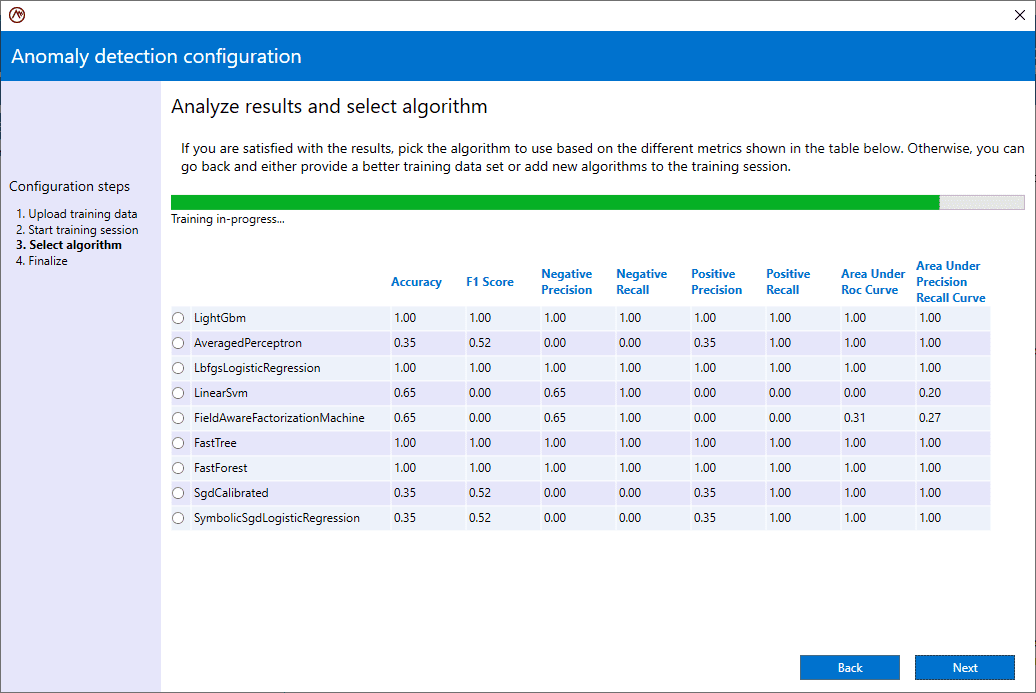
The output of this process is a real-time digital twin model which can be deployed to the streaming service. As each motor reports its telemetry to the streaming service, a unique real-time digital twin “instance” (a software object) is created to track that motor’s telemetry using the ML algorithm.
In addition to supervised learning, ML.NET provides an algorithm (called an adaptive kernel density estimation algorithm) for spike detection, which detects rapid changes in telemetry for a single parameter. The ScaleOut Model Development Tool lets users add spike detection for selected parameters using this algorithm. In addition, it is often useful to detect unusual but subtle changes in a parameter’s telemetry over time. For example, if the temperature for an electric motor is expected to remain constant, it would be useful to detect a slow rise in temperature that might otherwise go unobserved. To address this need, the tool lets users make use of a ScaleOut-developed, linear regression algorithm that detects and reports inflection points in the telemetry for a single parameter. These two techniques for tracking changes in a telemetry parameter are illustrated below:

Summing Up
Machine learning provides important real-time insights that enhance situational awareness and enable fast, effective responses. They often can provide useful analytics for complex datasets that cannot be analyzed with hand-coded algorithms. Their usefulness and rate of adoption is quickly growing. Using the ScaleOut Model Development Tool, real-time digital twins now can easily be enhanced to automatically analyze incoming telemetry messages with machine learning techniques that take full advantage of Microsoft’s ML.NET library. The integration of machine learning with real-time digital twins enables thousands of data streams to be automatically and independently analyzed in real-time with fast, scalable performance. Best of all, no coding is required, enabling fast, easy model development. By combining ML with real-time digital twins, the ScaleOut Digital Twin Streaming Service adds important new capabilities for real-time streaming analytics that supercharge the Azure IoT ecosystem.
Read more about the ScaleOut Model Development Tool.
The post Machine Learning Supercharges Real-Time Digital Twins appeared first on ScaleOut Software.
]]>The post The Need for Real-Time Device Tracking appeared first on ScaleOut Software.
]]>Real-Time Device Tracking with In-Memory Computing Can Fill an Important Gap in Today’s Streaming Analytics Platforms
We are increasingly surrounded by intelligent IoT devices, which have become an essential part of our lives and an integral component of business and industrial infrastructures. Smart watches report biometrics like blood pressure and heartrate; sensor hubs on long-haul trucks and delivery vehicles report telemetry about location, engine and cargo health, and driver behavior; sensors in smart cities report traffic flow and unusual sounds; card-key access devices in companies track entries and exits within businesses and factories; cyber agents probe for unusual behavior in large network infrastructures. The list goes on.
The Limitations of Today’s Streaming Analytics
How are we managing the torrent of telemetry that flows into analytics systems from these devices? Today’s streaming analytics architectures are not equipped to make sense of this rapidly changing information and react to it as it arrives. The best they can usually do in real-time using general purpose tools is to filter and look for patterns of interest. The heavy lifting is deferred to the back office. The following diagram illustrates a typical workflow. Incoming data is saved into data storage (historian database or log store) for query by operational managers who must attempt to find the highest priority issues that require their attention. This data is also periodically uploaded to a data lake for offline batch analysis that calculates key statistics and looks for big trends that can help optimize operations.
![]()
What’s missing in this picture? This architecture does not apply computing resources to track the myriad data sources sending telemetry and continuously look for issues and opportunities that need immediate responses. For example, if a health tracking device indicates that a specific person with known health condition and medications is likely to have an impending medical issue, this person needs to be alerted within seconds. If temperature-sensitive cargo in a long haul truck is about to be impacted by an erratic refrigeration system with known erratic behavior and repair history, the driver needs to be informed immediately. If a cyber network agent has observed an unusual pattern of failed login attempts, it needs to alert downstream network nodes (servers and routers) to block the kill chain in a potential attack.
A New Approach: Real-Time Device Tracking
To address these challenges and countless others like them, we need autonomous, deep introspection on incoming data as it arrives and immediate responses. The technology that can do this is called in-memory computing. What makes in-memory computing unique and powerful is its two-fold ability to host fast-changing data in memory and run analytics code within a few milliseconds after new data arrives. It can do this simultaneously for millions of devices. Unlike manual or automatic log queries, in-memory computing can continuously run analytics code on all incoming data and instantly find issues. And it can maintain contextual information about every data source (like the medical history of a device wearer or the maintenance history of a refrigeration system) and keep it immediately at hand to enhance the analysis. While offline, big data analytics can provide deep introspection, they produce answers in minutes or hours instead of milliseconds, so they can’t match the timeliness of in-memory computing on live data.
The following diagram illustrates the addition of real-time device tracking with in-memory computing to a conventional analytics system. Note that it runs alongside existing components. It adds the ability to continuously examine incoming telemetry and generate both feedback to the data sources (usually, devices) and alerts for personnel in milliseconds:
![]()
In-Memory Computing with Real-Time Digital Twins
Let’s take a closer look at today’s conventional streaming analytics architectures, which can be hosted in the cloud or on-premises. As shown in the following diagram, a typical analytics system receives messages from a message hub, such as Kafka, which buffers incoming messages from the data sources until they can be processed. Most analytics systems have event dashboards and perform rudimentary real-time processing, which may include filtering an aggregated incoming message stream and extracting patterns of interest. These real-time components then deliver messages to data storage, which can include a historian database for logging and query and a data lake for offline, batch processing using big data tools such as Spark:
![]()
Conventional streaming analytics systems run either manual queries or automated, log-based queries to identify actionable events. Since big data analyses can take minutes or hours to run, they are typically used to look for big trends, like the fuel efficiency and on-time delivery rate of a trucking fleet, instead of emerging issues that need immediate attention. These limitations create an opportunity for real-time device tracking to fill the gap.
As shown in the following diagram, an in-memory computing system performing real-time device tracking can run alongside the other components of a conventional streaming analytics solution and provide autonomous introspection of the data streams from each device. Hosted on a cluster of physical or virtual servers, it maintains memory-based state information about the history and dynamically evolving state of every data source. As messages flow in, the in-memory compute cluster examines and analyzes them separately for each data source using application-defined analytics code. This code makes use of the device’s state information to help identify emerging issues and trigger alerts or feedback to the device. In-memory computing has the speed and scalability needed to generate responses within milliseconds, and it can evaluate and report aggregate trends every few seconds.
![]()
Because in-memory computing can store contextual data and process messages separately for each data source, it can organize application code using a software-based digital twin for each device, as illustrated in the diagram above. Instead of using the digital twin concept to model the inner workings of the device, a real-time digital twin tracks the device’s evolving state coupled with its parameters and history to detect and predict issues needing immediate attention. This provides an object-oriented mechanism that simplifies the construction of real-time application code that needs to evaluate incoming messages in the context of the device’s dynamic state. For example, it enables a medical application to determine the importance of a change in heart rate for a device wearer based on the individual’s current activity, age, medications, and medical history.
Summing Up
The complex web of communicating devices that surrounds us needs intelligent, real-time device tracking to extract its full benefits. Conventional streaming analytics architectures have not kept up with the growing demands of IoT. With its combination of fast data storage, low-latency processing and ease of use, in-memory computing can fill the gap while complementing the benefits provided by historian databases and data lakes. It can add the immediate feedback that IoT applications need and boost situational awareness to a new level, finally enabling IoT to deliver on its promises.
The post The Need for Real-Time Device Tracking appeared first on ScaleOut Software.
]]>The post Adding New Capabilities for Real-Time Analytics to Azure IoT appeared first on ScaleOut Software.
]]>
The population of intelligent IoT devices is exploding, and they are generating more telemetry than ever. Whether it’s health-tracking watches, long-haul trucks, or security sensors, extracting value from these devices requires streaming analytics that can quickly make sense of the telemetry and intelligently react to handle an emerging issue or capture a new opportunity.
The Microsoft Azure IoT ecosystem offers a rich set of capabilities for processing IoT telemetry, from its arrival in the cloud through its storage in databases and data lakes. Acting as a switchboard for incoming and outgoing messages, Azure IoT Hub forms the core of these capabilities. It provides support for a range of message protocols, buffering, and scalable message distribution to downstream services. These services include:
- Azure Event Grid for routing incoming events to a variety of handlers, including serverless functions, webhooks, storage queues, and other services
- Azure IoT Central for managing devices, visualizing incoming telemetry on a dashboard, triggering alerts, and integrating with line-of-business applications
- Azure Stream Analytics for simultaneously analyzing aggregated telemetry streams using extended SQL queries to extract patterns that can be fed to workflows, including alerts, serverless functions, and data storage with offline processing
- Azure Time Series Insights for storing time-series data and then exploring, modeling, and querying it to gain insights, such as identifying anomalies and trends, with a rich set of analytics tools
- Azure Digital Twins for creating a graphical representation of the assets within an organization using the Digital Twin Definition Language, processing events, and visualizing entity graphs to display and query status
While Azure IoT offers a wide variety of services, it focuses on visualizing entities and events, extracting insights from telemetry streams with queries, and migrating events to storage for more intensive offline analysis. What’s missing is continuous, real-time introspection on the dynamic state of IoT devices to predict and immediately react to significant changes in their state. These capabilities are vitally important to extract the full potential of real-time intelligent monitoring.
For example, here are some scenarios in which stateful, real-time introspection can create important insights. Telemetry from each truck in a fleet of thousands can provide numerous parameters about the driver (such as repeated lateral accelerations at the end of a long shift) that might indicate the need for a dispatcher to intervene. A health tracking device might indicate a combination of signals (blood pressure, blood oxygen, heart rate, etc.) that indicate an emerging medical issue for an individual with a known medical history and current medications. A security sensor in a key-card access system might indicate an unusual pattern of building entries for an employee who has given notice of resignation.
In all of these examples, the event-processing system needs to be able to independently analyze events for each data source (IoT device) within milliseconds, and it needs immediate access to dynamic, contextual information about the data source that it can use to perform real-time predictive analytics. In short, what’s needed is a scalable, in-memory computing platform connected directly to Azure IoT Hub which can ingest and process event messages separately for each data source using memory-based state information maintained for that data source.
The ScaleOut Digital Twin Streaming Service provides precisely these capabilities. It does this by leveraging the digital twin concept (not to be confused with Azure Digital Twins) to create an in-memory software object for every data source that it is tracking. This object, called a real-time digital twin, holds dynamic state information about the data source and is made available to the application’s event handling code, which runs within 1-2 milliseconds whenever an incoming event is received. Application developers write event handling code in C#, Java, JavaScript, or using a rules engine; this code encapsulates application logic, such as a predictive analytics or machine learning algorithm. Once the real-time digital twin’s model (that is, its state data and event handling code) has been created, the developer can use an intuitive UI to deploy it to the streaming service and connect to Azure IoT Hub.
provides precisely these capabilities. It does this by leveraging the digital twin concept (not to be confused with Azure Digital Twins) to create an in-memory software object for every data source that it is tracking. This object, called a real-time digital twin, holds dynamic state information about the data source and is made available to the application’s event handling code, which runs within 1-2 milliseconds whenever an incoming event is received. Application developers write event handling code in C#, Java, JavaScript, or using a rules engine; this code encapsulates application logic, such as a predictive analytics or machine learning algorithm. Once the real-time digital twin’s model (that is, its state data and event handling code) has been created, the developer can use an intuitive UI to deploy it to the streaming service and connect to Azure IoT Hub.
As shown in the following diagram, ScaleOut’s streaming service connects to Azure IoT Hub, runs alongside other Azure IoT services, and provides unique capabilities that enhance the overall Azure IoT ecosystem:

ScaleOut’s streaming service handles all the details of message delivery, data management, code orchestration, and scalable execution. This makes developing streaming analytics code for real-time digital twins fast and easy. The application developer just focuses on writing a single method to process incoming messages, run application-specific analytics, update state information about the data source, and generate alerts as needed. The optional rules engine further simplifies the development process with a UI for specifying state data and a sequential list of business rules for describing analytics code.
How are the streaming service’s real-time digital twins different from Azure digital twins? Both services leverage the digital twin concept by providing a software entity for each IoT device that can track the parameters and state of the device. What’s different is the streaming service’s focus on real-time analytics and its use of an in-memory computing platform integrated with Azure IoT Hub to ensure the lowest possible latency and high scalability. Azure digital twins serve a different purpose. They are intended to maintain a graphical representation of an organization’s entities for management and querying current status; they are not designed to implement real-time analytics using application-defined algorithms.
The following diagram illustrates the integration of ScaleOut’s streaming service with Azure IoT Hub to provide fast, scalable event handling with low-latency access to memory-based state for all data sources. It shows how real-time digital twins are distributed across multiple virtual servers organized into an in-memory computing cluster connected to Azure IoT Hub. The streaming service uses multiple message queues in Azure IoT Hub to scale message delivery and event processing:

As IoT devices proliferate and become more intelligent, it’s vital that our cloud-based event-processing systems be able to perform continuous and deep introspection in real time. This enables applications to react quickly, effectively, and autonomously to emerging challenges, such as to security threats and safety issues, as well as to new opportunities, such as real-time ecommerce recommendations. While there is an essential role for query and offline analytics to optimize IoT services, the need for highly granular, real-time analytics continues to grow. ScaleOut’s Digital Twin Streaming Service is designed to meet this need as an integral part of the Azure IoT ecosystem.
To learn more about using the ScaleOut’s Digital Twin Streaming Service in the Microsoft Azure cloud, visit the Azure Marketplace here.
The post Adding New Capabilities for Real-Time Analytics to Azure IoT appeared first on ScaleOut Software.
]]>The post New Article in RT Insights on Tracking Vaccine Distribution with Real-Time Digital Twins appeared first on ScaleOut Software.
]]>The post New Article in RT Insights on Tracking Vaccine Distribution with Real-Time Digital Twins appeared first on ScaleOut Software.
]]>The post Building the Next Generation in Physical and Cyber Security with Real-Time Digital Twins appeared first on ScaleOut Software.
]]>
In-Memory Computing with Real-Time Digital Twins Offers the Intelligence, Responsiveness, Agility, and Scalability that Security and Safety Systems are Missing
Today’s physical and cyber security systems need to quickly detect and respond to unauthorized intrusions. However, these systems typically do not take advantage of in-memory computing techniques to help them immediately assess threats and generate alerts. In-memory computing with real-time digital twins offers a powerful new tool to address these challenges. Because these software components independently analyze telemetry from each data source and maintain dynamic contextual information, they can immediately spot unwanted intrusions and generate alerts. Let’s take a look at how they can add value.
Physical Security and Safety
Consider physical security with key card access control used by countless businesses and industries. Key card access control systems rely on database servers in the back office to authorize key cards for specific card readers and to log usage. As illustrated below, this information propagates to field access panels in the buildings to minimize delays in authorizing access. However, making changes usually requires manual database updates and may take minutes or longer to propagate throughout the system.

More importantly, subtle patterns of unauthorized access may escape the attention of security personnel and require a review of the logs to detect. For example, an employee who has given notice of resignation may unexpectedly visit buildings or laboratories that were not part of the employee’s known scope of work. Another employee might be put at risk by attempting to enter a hazardous laboratory without having completed the required training. An exit door might record an unusual pattern of entries outside of business hours. In all of these situations, quick detection and response could avoid unwanted intrusions or safety lapses.
To enable immediate alerting, real-time digital twins (RTDTs) can be used to track every key card and key card reader. Since each key card is associated with a specific employee, the RTDT can track that person’s individual authorization to access buildings, entry doors, laboratories, etc. It also can track employment status and level of training to help assess safety issues. This information can be immediately updated by sending a message to the RTDT whenever the employee’s status changes. With this contextual information, each RTDT can implement highly granular access permissions at the card readers while checking authorization within several milliseconds. It also can track the employee’s and entry point’s usage patterns to look for unusual situations that should be alerted.
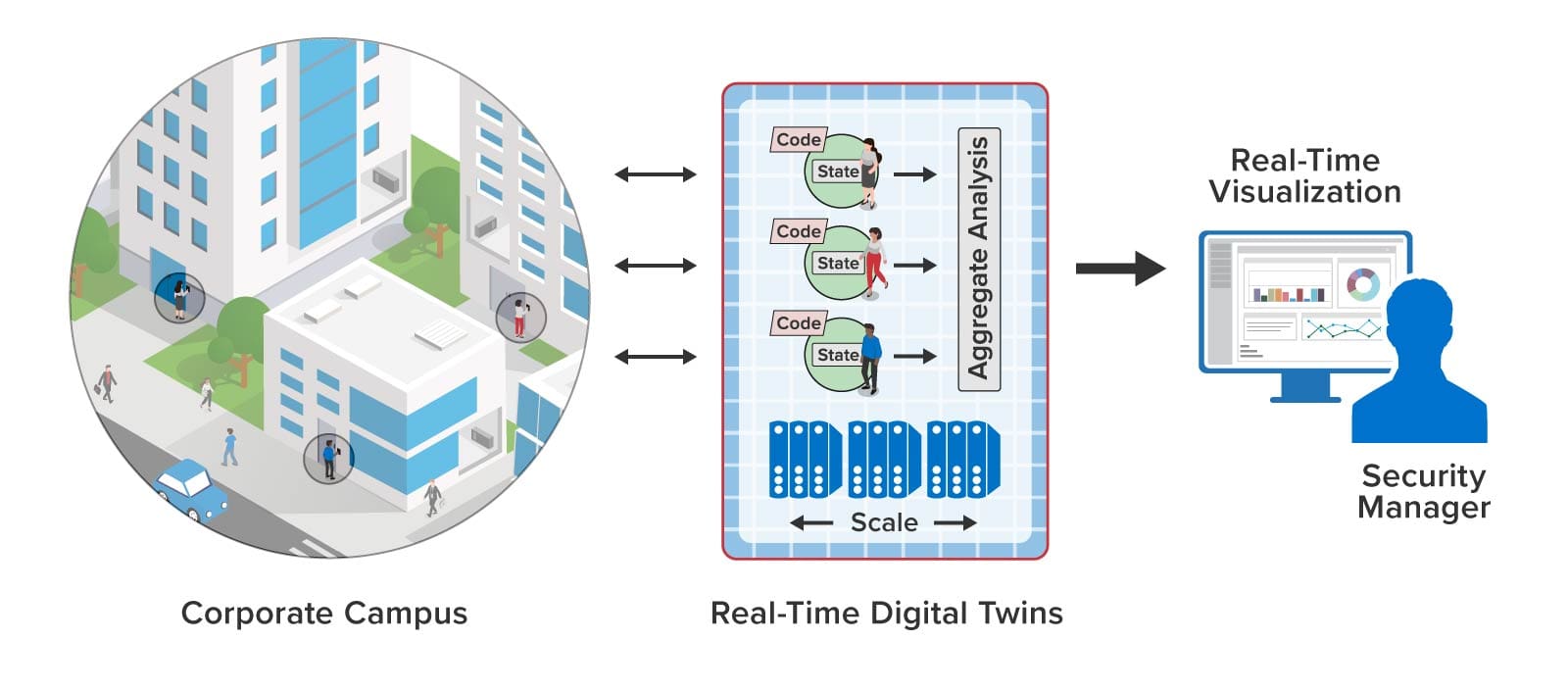
In a typical interaction, the key card reader sends a message to the employee’s key card RTDT with the reader’s identifier and time of day. After analyzing the request and tracking usage patterns, the key card RTDT responds with an authorization reply to the reader. The RTDT also sends a message to the reader’s RTDT to enable it to track usage and generate alerts as necessary, as illustrated below:

Cyber Security
Security information and event management (SIEM) software logs activities, such as user logins, failed attempts, and potentially malicious events so that security managers can detect and prevent or remediate possible intrusions. Typical SIEM software lets managers create and apply rules to event logs to extract information that should be alerted, such as identification of a chain of activity (“kill chain”) that leads to injection of malware or other malicious actions. Dashboards show managers raw telemetry, such as the number of potentially malicious events by region or events recorded over time. The forensic analysis of logs and display of large volumes of aggregated telemetry make it difficult for managers to spot and mitigate emerging kill chains, such as a chain of intrusions within a corporate infrastructure leading to an exploitation:
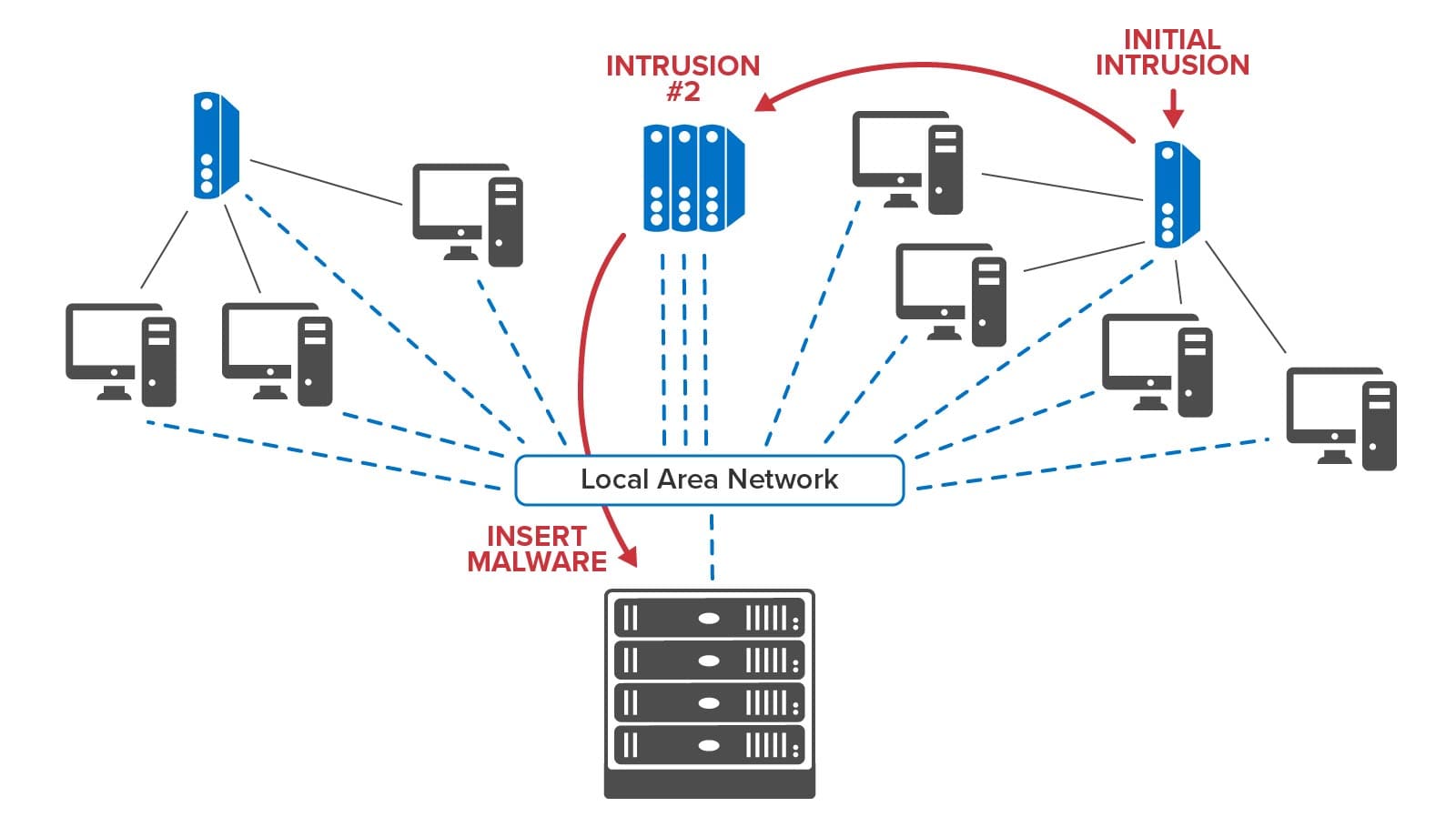
By hosting event tracking in memory with contextual information and by reacting within milliseconds to potential threats, RTDTs can help accelerate the detection and interruption of cyber kill chains. Many SIEM platforms maintain software agents distributed throughout an organization’s IT infrastructure to report suspicious events that could signal a possible intrusion. Instead of just feeding these events to a dashboard and to a log for analysis, they can also be reported to an RTDT for each agent. Each RTDT can immediately run a machine learning algorithm to classify activity and signal alerts when a threat is predicted. Moreover, if an agent’s event includes information about an outbound connection to another node in the network, the RTDT can send a message to that node’s RTDT to enrich its context and assist in detection of a potential kill chain. By dynamically sending messages to and among RTDTs that attempt to track the progression of an intruder within a network, RTDTs can build a real-time map of potential kill chains and possibly get ahead of the intruder to block threats.
The following diagram illustrates the use of RTDTs to map the progression of incoming threats as they migrate among nodes of an organization’s infrastructure:
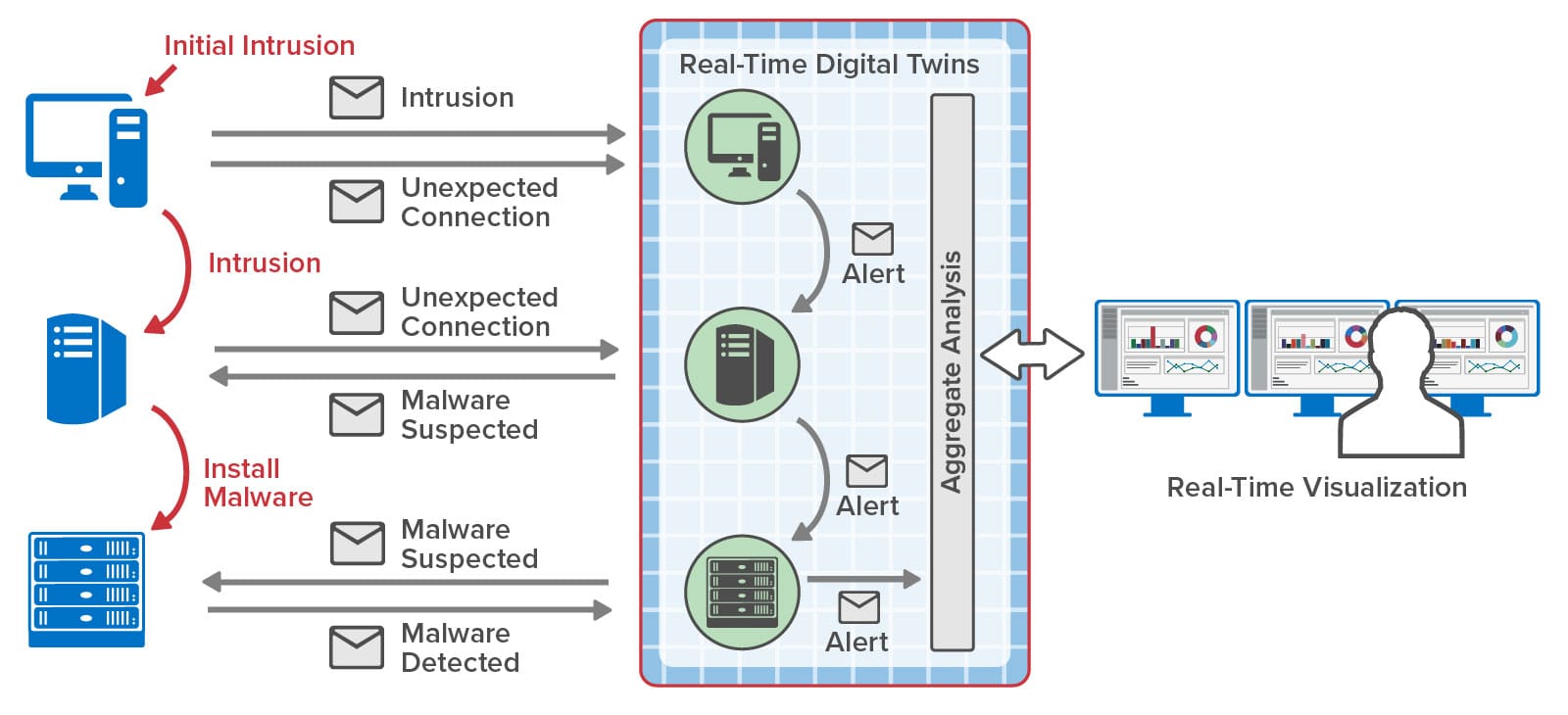
Summing Up
Physical and cyber security systems, as well as safety systems, require simultaneous, real-time assessment of numerous interactions in the context of allowed and expected usage patterns. Instead of relying on today’s offline computing techniques and forensic analysis to perform the bulk of the work, these systems can dramatically boost their effectiveness by employing next generation in-memory computing techniques, such as real-time digital twins. This software architecture offers a highly attractive combination of intelligence, agility, responsiveness, and scalability to meet the ever-increasing challenges faced by today’s security and safety systems.
The post Building the Next Generation in Physical and Cyber Security with Real-Time Digital Twins appeared first on ScaleOut Software.
]]>The post Deploying Real-Time Digital Twins On Premises with ScaleOut StreamServer DT appeared first on ScaleOut Software.
]]>
With the ScaleOut Digital Twin Streaming Service , an Azure-hosted cloud service, ScaleOut Software introduced breakthrough capabilities for streaming analytics using the real-time digital twin concept. This new software model enables applications to easily analyze telemetry from individual data sources in 1-3 milliseconds while maintaining state information about data sources that deepens introspection. It also provides a basis for applications to create key status information that the streaming platform aggregates every few seconds to maximize situational awareness. Because it runs on a scalable, highly available in-memory computing platform, it can do all this simultaneously for hundreds of thousands or even millions of data sources.
, an Azure-hosted cloud service, ScaleOut Software introduced breakthrough capabilities for streaming analytics using the real-time digital twin concept. This new software model enables applications to easily analyze telemetry from individual data sources in 1-3 milliseconds while maintaining state information about data sources that deepens introspection. It also provides a basis for applications to create key status information that the streaming platform aggregates every few seconds to maximize situational awareness. Because it runs on a scalable, highly available in-memory computing platform, it can do all this simultaneously for hundreds of thousands or even millions of data sources.
The unique capabilities of real-time digital twins can provide important advances for numerous applications, including security, fleet telematics, IoT, smart cities, healthcare, and financial services. These applications are all characterized by numerous data sources which generate telemetry that must be simultaneously tracked and analyzed, while maintaining overall situational awareness that immediately highlights problems of concern an/or opportunities of interest. For example, consider some of the new capabilities that real-time digital twins can provide in fleet telematics and vaccine distribution during COVID-19.
To address security requirements or the need for tight integration with existing infrastructure, many organizations need to host their streaming analytics platform on-premises. Scaleout StreamServer® DT was created to meet this need. It combines the scalable, battle-tested in-memory data grid that powers ScaleOut StreamServer with the graphical user interface and visualization features of the cloud service in a unified, on-premises deployment. This gives users all of the capabilities of the ScaleOut Digital Twin Streaming Service with complete infrastructure control.
As illustrated in the following diagram, ScaleOut StreamServer DT installs its management console on a standalone server that connects to ScaleOut StreamServer’s in-memory data grid. This console hosts the graphical user interface that is securely accessed by remote workstations within an organization. It also deploys real-time digital twin models to the in-memory data grid, which hosts instances of digital twins (one per data source) and runs application-defined code to process incoming messages. Message are delivered to the grid using messaging hubs, such as Azure IoT Hub, AWS IoT Core, Kafka, a built-in REST service, or directly using APIs.

The management console installs as a set of Docker containers on the management server. This simplifies the installation process and ensures portability across operating systems. Once installed, users can create accounts to control access to the console, and all connections are secured using SSL. The results of aggregate analytics and queries performed within the in-memory data grid can then be accessed and visualized on workstations running throughout an organization.
Because ScaleOut’s in-memory data grid runs in an organization’s data center and avoids the requirement to use a cloud-hosted message hub or REST service, incoming messages from data sources can be processed with minimum latency. In addition, application code running in real-time digital twins can access local resources, such as databases and alerting systems, with the best possible performance and security. Use of dedicated computing resources for the in-memory data grid delivers the highest possible throughput for message processing and real-time analytics.
While cloud hosting of streaming analytics as a SaaS (software-as-a-service) offering creates clear advantages in reducing capital costs and providing access to highly elastic computing resources, it may not be suitable for organizations which need to maintain full control of their infrastructures to address security and performance requirements. ScaleOut StreamServer DT was designed to meet these needs and deliver the important, unique benefits of streaming analytics using real-time digital twins to these organizations.
The post Deploying Real-Time Digital Twins On Premises with ScaleOut StreamServer DT appeared first on ScaleOut Software.
]]>The post ScaleOut Named as Leading Innovator for Stream Processing appeared first on ScaleOut Software.
]]> , ScaleOut’s ground-breaking, Azure-hosted cloud service leverages the power of in-memory computing to let applications track hundreds of thousands of data sources (or more) in real time. With its ability to deepen introspection on the state of data sources and visualize aggregate trends within seconds, this cloud service opens up important new capabilities for a wide range of applications, including those in telematics, logistics, cyber/physical security, IoT, smart cities, financial services, and much more.
, ScaleOut’s ground-breaking, Azure-hosted cloud service leverages the power of in-memory computing to let applications track hundreds of thousands of data sources (or more) in real time. With its ability to deepen introspection on the state of data sources and visualize aggregate trends within seconds, this cloud service opens up important new capabilities for a wide range of applications, including those in telematics, logistics, cyber/physical security, IoT, smart cities, financial services, and much more.
The power of this breakthrough new technology has gained the attention of leading industry analysts. In their recent Data Management: IoT Stream Processing and Streaming Analytics competitive ranking report, ABI Research named ScaleOut Software as the leading vendor in innovation “owing to its highly effective Digital Twin Streaming Service that can track telemetry streams, data aggregation tools, and trend recognition capabilities of multiple devices’ telemetry.”
The full press release from ABI Research can be found here.
The post ScaleOut Named as Leading Innovator for Stream Processing appeared first on ScaleOut Software.
]]>The post ScaleOut Software Joins Digital Twin Consortium to Share Streaming Analytics Expertise appeared first on ScaleOut Software.
]]>BELLEVUE, Wash – March 2, 2021 – ScaleOut Software today announced that it has joined Digital Twin Consortium to help define and advance the use of digital twin technologies across various industries.
“We are excited to join the Digital Twin Consortium,” said Dr. William L. Bain, founder, and CEO of ScaleOut Software. “We believe that digital twins offer great promise across numerous industries from telematics to IIoT, healthcare, physical security and eCommerce. They can dramatically improve situational awareness for managers of live systems spanning thousands or even millions of data sources, and we are delighted to help raise awareness of the concept of harnessing digital twins for streaming analytics via the Consortium.”
As defined by Digital Twin Consortium, the digital twin concept encompasses use cases for both product lifecycle management (PLM), where the idea originated, and for real-time streaming analytics for live systems. ScaleOut Software’s real-time digital twin technology represents the latter approach and adopts this concept for streaming analytics. The company’s “real-time digital twin” software architecture for streaming analytics across industries provides more informed decision making in the moment for applications that track thousands of data sources.
Real-time digital twins create a “model” of each individual data source as they track the specific characteristics relevant for the goals of streaming analytics, such as detecting anomalous conditions or predicting failures. This generalization of the modeling concept allows digital twins to analyze not only physical devices but also a wide array of data sources that would not be typically considered, such as ecommerce shoppers for a recommendation system.
“We welcome ScaleOut Software to Digital Twin Consortium,” said Executive Director, Dr. Richard Soley. “Their knowledge of real-time digital twin software and streaming analytics will be very valuable to our members as we work together to advance digital twin technologies.”
Harnessing the Digital Twin Model
ScaleOut Software’s streaming analytics platform leverages the digital twin concept by associating a software component, called a “real-time digital twin,” with every data source to analyze the incoming telemetry from that data source. Large systems, such as trucking fleets or access control systems, often require thousands of data sources to be simultaneously monitored. Each real-time digital twin maintains dynamic state information that assists in predictive analytics and other use cases. This enables deeper inferencing about the evolving state of each data source than otherwise possible.
When run on a scalable, in-memory computing platform, real-time digital twins dramatically increase the amount of analysis that can be performed as telemetry arrives, and they avoid the delays incurred by offline, big-data analytics. The in-memory platform can simultaneously host thousands or even millions of digital twins to ensure predictable response times, and it can continuously aggregate state information for immediate visualization.
Benefits of Real-Time Digital Twins for Streaming Analytics
Real-time digital twins:
- Provide Immediate, Contextual Insights: Real-time digital twins allow the telemetry from a large population of data sources to be immediately and independently tracked, analyzed, and filtered, while making use of dynamically evolving contextual information. They enable feedback and alerts to be generated within a few milliseconds.
- Aggregate Insights to Identify Trends and Issues: Real-time digital twins maintain dynamic state information that can be aggregated and visualized to identify important trends or issues within seconds. This capability dramatically boosts overall situational awareness for managers of live systems.
- Simplify Development and Deployment: Real-time digital twins offer a compelling technique for simplifying application code and shortening design time. The digital twin model can be implemented using well understood, standard, object-oriented techniques that encapsulate analytics code and state information. This enables fast development and agility to meet evolving requirements.
For more information, please visit www.scaleoutsoftware.com and follow @ScaleOut_Inc on Twitter.
Additional Resources:
- ScaleOut Digital Twin Streaming Service Product Page
- Announcing the ScaleOut Digital Twin Streaming Service
 Blog Post
Blog Post - Developing Real-Time Digital Twins for Cloud Deployment Blog Post
About ScaleOut Software
Founded in 2003, ScaleOut Software develops leading-edge software that delivers scalable, highly available, in-memory computing and streaming analytics technologies to a wide range of industries. ScaleOut Software’s in-memory computing platform enables operational intelligence by storing, updating, and analyzing fast-changing, live data so that businesses can capture perishable opportunities before the moment is lost. It has offices in Bellevue, Washington and Beaverton, Oregon.
###
Contact:
RH Strategic for ScaleOut Software
206-264-0246
The post ScaleOut Software Joins Digital Twin Consortium to Share Streaming Analytics Expertise appeared first on ScaleOut Software.
]]>The post Real-Time Digital Twins Can Help Expedite Vaccine Distribution appeared first on ScaleOut Software.
]]>Agile In-Memory Software Can Track the Dynamic Rollout of Vaccine Distribution and Delivery to Quickly Spot Problems
Getting the COVID-19 crisis under control requires that we put in place an effective process for vaccine distribution so that the country can get to herd immunity as fast as possible. We are faced with quickly building a nationwide logistics network and standing up well more than 50,000 vaccination centers. Making all this work smoothly means that managers need accurate, up-to-the-minute information about all aspects of this operation, including:
- Where are all the vaccine shipments right now?
- What is the shortfall in vaccines at each center?
- How many people are waiting for vaccines at each center?
- How many qualified personnel are available at each center?
- Which centers have the most urgent needs and need immediate attention?
- Is vaccine distribution underserving certain regions or population groups?
Given the unique and highly dynamic nature of this challenge, we need software solutions that are agile enough to adapt to evolving needs and scalable enough to quickly handle a daunting amount of fast-changing data. Conventional, enterprise data architectures take months to develop and are complex to change. Is there a simpler, faster way to wrangle this data for crisis managers?
In-Memory Computing with Real Time Digital Twins: Fast and Agile
A software technology called in-memory computing has evolved over the last twenty years to grapple with the challenge of tracking and analyzing fast-changing data. Its two core competencies are speed and scalability. Widely used to track ecommerce shopping carts, financial transactions, airline flights and much more, in-memory computing can quickly store, retrieve, and analyze large volumes of live data. This powerful technology may also be just what we need to help tackle the challenge of vaccine distribution.
In the last two years, the concept of real-time digital twins has emerged to let in-memory computing track incoming data streams from hundreds of thousands of data sources, maintain pertinent information about each data source, and immediately alert when unusual conditions are detected. The power of this approach lies in its ability to simplify the problem for application developers. It encapsulates code that just focuses on analyzing messages from a single data source as they flow in, and it maintains an up-to-the second assessment of the data source’s status. Real-time digital twins are both easy to develop and easy to change as needs evolve. The in-memory computing system which hosts them typically runs as a cloud service (such as the ScaleOut Digital Twin Streaming Service) that transparently scales to handle as many data sources as needed.
Real-Time Digital Twins Can Help Expedite Vaccine Distribution
To track the distribution and delivery of COVID-19 vaccines, a real-time digital twin can be deployed for each shipment in transit and for each vaccination center. For shipments, the digital twins can track location, destination, and current condition on a second-by-second basis, allowing managers to instantly know where a shipment is and whether its viability is at risk, for example, due to a temperature change. For vaccination centers, real-time digital twins can track location, the supply of vaccines, current demand (number of recipients), availability of trained personnel to perform injections, and other parameters. Code in the digital twin continuously analyzes incoming messages to determine whether a problem exists or is likely to occur, and it alerts managers to urgent issues within a few milliseconds. This allows managers to keep track of which of the 50,000 centers need immediate assistance.
The following diagram illustrates the use of real-time digital twins to track thousands of vaccine shipments and vaccination centers. The red dotted lines depict message streams flowing from data sources located throughout the country over the Internet to their corresponding real-time digital twins hosted in the cloud service.
![]()
Let’s take a closer look at the real-time digital twin for a vaccination center. Using a simple web app, personnel at the vaccination center send periodic messages updating information about supplies, personnel, recipients, and wait times. The real time digital twin for this center records this data and then analyzes it for issues, such as a shortfall in supplies, lack of available personnel, or a surge in incoming recipients. It can then compute an assessment of the urgency for assistance (call it an alert level) which can be compared to other centers to identify which ones have the most urgent issues. If the alert level becomes sufficiently high, the analysis code can immediately notify managers. By analyzing incoming messages, real-time digital twins keep track of the latest status for all vaccination centers.
Here’s an illustration of a vaccination center sending messages to its real-time digital twin running in the cloud. It shows some of the state information that the twin maintains and the code which analyzes incoming messages as they arrive:
![]()
Aggregate Analytics Boost Situational Awareness
When dealing with thousands of dynamic data sources, managers can use real-time digital twins to serve as highly responsive watchdogs that continuously evaluate incoming information for changes that may need attention. This helps managers easily track thousands of data sources and focus on the most pressing concerns.
To further boost situational awareness, the in-memory computing platform can group and aggregate data held in the real-time digital twins every few seconds to help surface widespread changes that need strategic responses. For example, the average shortfall in vaccine doses for all centers in each region of the country can be aggregated to track where shortfalls may be occurring. This information can be visualized as shown in the chart below, which is updated every few seconds to provide managers with the most current view of the situation:

Likewise, this technique can be used to aggregate the average wait times for all vaccination centers by county. This can help determine where bottlenecks in vaccine delivery are occurring and enable mangers to render assistance by relocating personnel from less busy centers to overwhelmed ones.
Aggregate analytics of data maintained by real-time digital twins can also be used to track and validate the equitable distribution of vaccines. For example, it can aggregate information collected from each center about the demographics of vaccine recipients, such as age and ethnicity, and characteristics of the centers themselves, such as hospitals vs pharmacies and urban vs rural. This allows key real-time statistics to be tracked, such whether certain groups or regions are being underserved and whether hospitals have shorter wait times than pharmacies.
Summing Up
Without a doubt, distributing and delivering COVID-19 vaccines quickly and effectively over the next few months presents formidable challenges, namely:
- Ensuring that logistics managers get the critical information they need in a timely manner
- Avoiding the complexity and delay required to build custom information management systems that can provide this information
Because it is fast, scalable, and agile, in-memory computing technology with real-time digital twins can serve as a valuable tool for tracking the status of many thousands of vaccination centers and shipments. This innovative software infrastructure can quickly be programmed to analyze vital parameters and statistics in milliseconds and aggregate key data every few seconds. It offers managers a powerful and flexible means for helping ensure fast, efficient vaccine distribution and delivery.
The post Real-Time Digital Twins Can Help Expedite Vaccine Distribution appeared first on ScaleOut Software.
]]>The post Building Real-Time Digital Twins with a Rules Engine appeared first on ScaleOut Software.
]]>
Simplified Creation of Analytics Logic Lowers the Learning Curve for Using Digital Twins in Streaming Analytics
As discussed in earlier blog posts, real-time digital twins offer a breakthrough new approach to streaming analytics by providing a means for continuously analyzing each incoming telemetry stream from thousands of data sources. Because they maintain state information about each data source, they can immediately spot issues unique to that data source and generate alerts within a few milliseconds. In contrast, conventional “batch-oriented” streaming analytics typically do not mine this telemetry in real-time and may not uncover important, actionable trends for several minutes or hours. These unique capabilities, combined with real-time data aggregation to boost situational awareness, give real-time digital twins unique advantages in a wide range of applications, including contact tracing, telematics, logistics, smart cities, security, financial services, healthcare, and much more.
Real-time digital twins provide a software technique for orchestrating the execution of analytics code that examines incoming messages from a single data source and maintains state information about that data source. The ScaleOut Digital Twin Streaming Service hosts instances of real-time digital twins in the Microsoft Azure cloud or on-premises, manages the delivery of messages from various message hubs, and implements data aggregation and visualization. Application developers typically implement a single method containing analytics code written in standard programming languages, such as Java, C#, and JavaScript, which take full advantage of the object-oriented, real-time digital twin model. Here is a depiction of a real-time digital twin showing the message processing code and state information unique to a specific data source:
hosts instances of real-time digital twins in the Microsoft Azure cloud or on-premises, manages the delivery of messages from various message hubs, and implements data aggregation and visualization. Application developers typically implement a single method containing analytics code written in standard programming languages, such as Java, C#, and JavaScript, which take full advantage of the object-oriented, real-time digital twin model. Here is a depiction of a real-time digital twin showing the message processing code and state information unique to a specific data source:
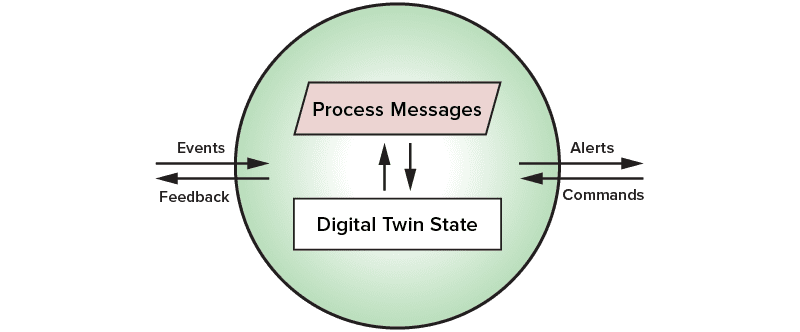
Rules-Based Real-Time Digital Twins
In many applications, a rules-based formulation of analytics logic can simplify application code and open up development of real-time digital twins to analysts who lack object-oriented programming experience. Rules-based algorithms have been widely adopted over the years and proven to provide a straightforward technique for expressing business logic in numerous applications and expert systems. In their simplest form, rules are expressed as “IF condition THEN action” statements which are executed sequentially by a “rules engine.” Other rules which just perform actions, such as calculations or message sending, can be expressed with “DO action” statements. These rules replace programming code with simple, highly readable statements that can be used in many applications where more complex logic is not required.
For example, consider an IoT application in which a real-time digital twin is monitoring messages sent from a thermometer and looking for a situation in which the temperature either spikes beyond an allowed limitof 250 deg. or exceeds an allowed average value of 112 deg. This logic could be expressed with the following rules, which are executed for each incoming message. Note that the temperature reading within the message is called Incoming.Temp here, and the other variables maintain state information within the real-time digital twin’s instance for this thermometer. For example, the number of temperature spikes is maintained in the variable NumEvents.
DO CurrentTemp = Incoming.Temp IF CurrentTemp > MaxTemp THEN MaxTemp = CurrentTemp DO AverageTemp = AverageTemp * NumSamples + CurrentTemp DO NumSamples = NumSamples + 1 DO AverageTemp = AverageTemp / NumSamples IF MaxTemp > 250.0 THEN NumEvents = NumEvents + 1 IF MaxTemp > 250.0 THEN LogMessage.Message = "Max temp exceeded" AND LogMessage IF AverageTemp > 112.0 THEN LogMessage.Message = "Average temp exceeded" AND LogMessage
The following diagram shows how message are delivered to a thermometer’s real-time digital twin instance and are analyzed by the rules engine:

Development Tool for Building Rules-Based Models
To simplify the development of rules-based analytics code for real-time digital twins, ScaleOut Software has developed the ScaleOut Rules Engine Development Tool . This Windows-based graphical development environment enables application developers to create and test rule-based digital twin models prior to deploying them on the streaming service for production use. Using this tool, developers create a model by specifying:
. This Windows-based graphical development environment enables application developers to create and test rule-based digital twin models prior to deploying them on the streaming service for production use. Using this tool, developers create a model by specifying:
- Instance properties to be tracked, such as AverageTemp, MaxTemp, and NumEvents in the example
- Message properties that will be used, such as Incoming.Temp for incoming messages
- Rules to be executed (like the ones listed above)
The tool validates the rules when they are created to make sure that they will execute. Next, the user can test the model by sending it messages and observing changes in the values of the properties. The rules can be run one at a time for each message to verify that they are creating the desired state changes and outgoing messages. The development tool can simulate sending message back to the data source, to another real-time digital twin instance, or to the message log in the service’s UI.
Here is a screenshot of the development tool during a test of a rules-based model for a thermometer:
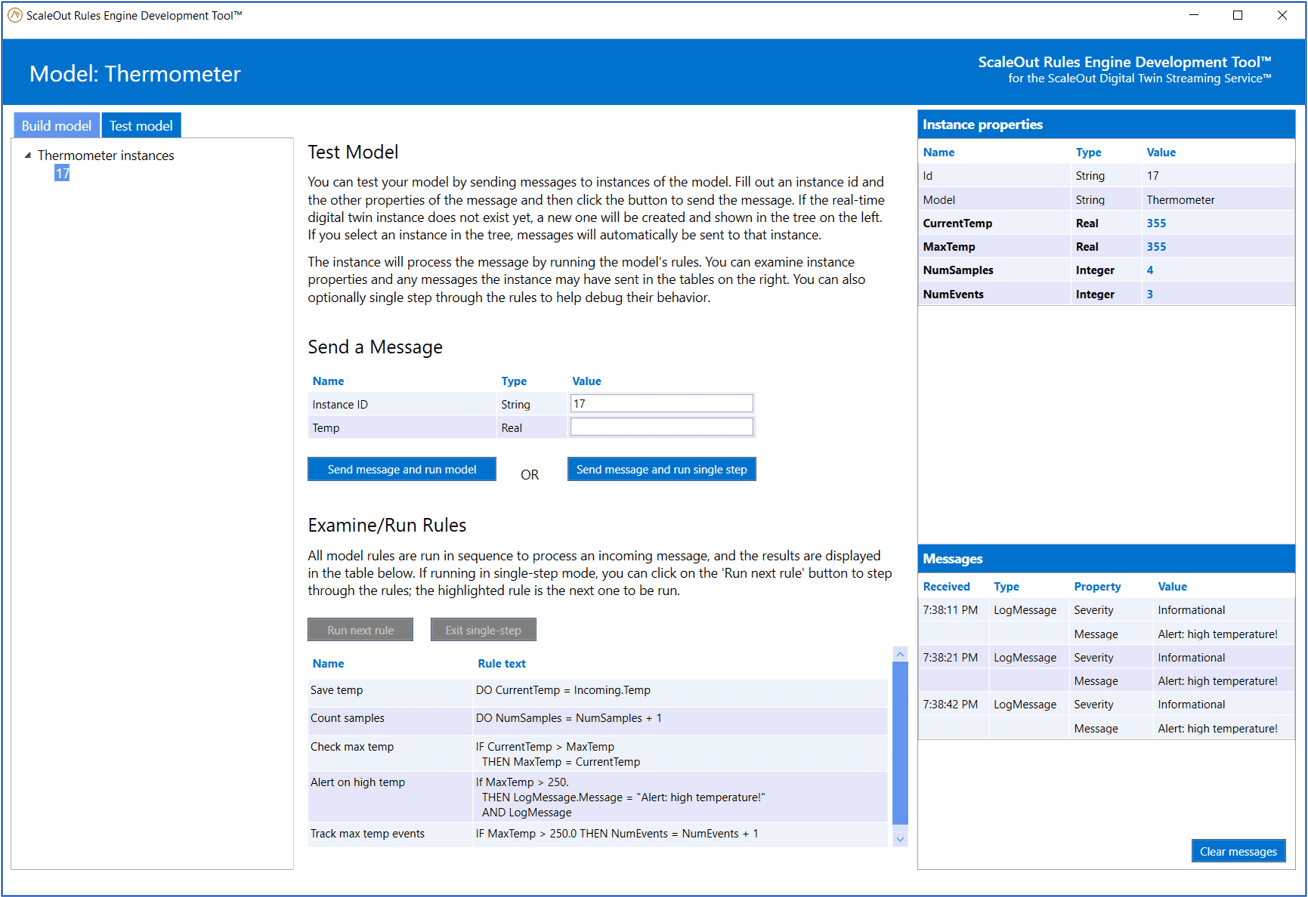
Note that during production use, the streaming service can aggregate instance properties across all real-time digital twin instances and visualize the results. The rules engine running in each real-time digital twin instance updates property values as it processes incoming messages, and the results are immediately aggregated. For example, if the thermometers supplied their locations, the average temperature could be plotted by region. This allows managers to immediately spot patterns in the data across all data sources and direct responses where they are most urgently needed.
Summing Up
The integration of a rules engine within real-time digital twins lowers barriers to entry in creating streaming analytics. The highly intuitive formulation of application logic as a set of rules to be sequentially evaluated makes it straightforward for domain experts to implement streaming analytics for many applications without the need for programming skills. The power of real-time digital twins working together, combined with continuous aggregate analytics, enables telemetry from many thousands of data sources to be simultaneously analyzed and creates a breakthrough in situational awareness.
The post Building Real-Time Digital Twins with a Rules Engine appeared first on ScaleOut Software.
]]>The post Real-Time Digital Twins: A New Approach to Streaming Analytics appeared first on ScaleOut Software.
]]>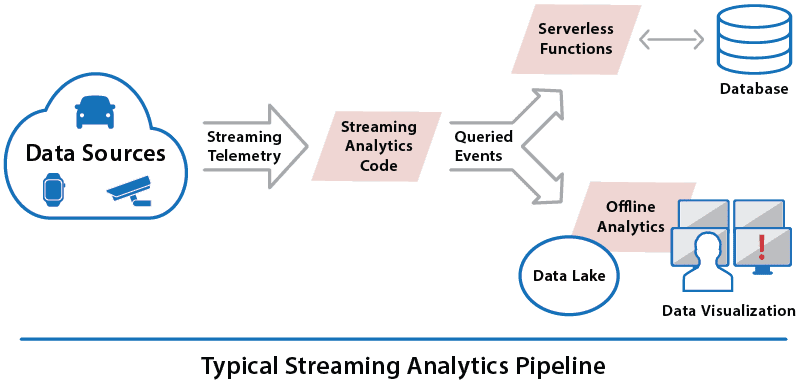
A conventional pipeline combines telemetry from all data sources into a single stream which is queried by the user’s streaming analytics application. This code often takes the form of a set of SQL queries (extended with time-windowing semantics) running continuously to select interesting events from the stream. These query results are then forwarded to a data lake for offline analytics using tools such as Spark and for data visualization. Query results also might be forwarded to cloud-based serverless functions to trigger alerts or other actions in conjunction with access to a database or blob store.
These techniques are highly effective for analyzing telemetry in aggregate to identify unusual situations which might require action. For example, if the telemetry is tracking a fleet of rental cars, a query could report all cars by make and model that have reported a mechanical problem more than once over the last 24 hours so that follow-up inquiries can be made. In another application, if the telemetry stream contains key-clicks from an e-commerce clothing site, a query might count how many times a garment of a given type or brand was viewed in the last hour so that a flash sale can be started.
A key limitation of this approach is that it is difficult to separately track and analyze the behavior of each individual data source, especially when they number in the thousands or more. It’s simply not practical to create a unique query tailored for each data source. Fine-grained analysis by data source must be relegated to offline processing in the data lake, making it impossible to craft individualized, real-time responses to the data sources.
For example, a rental car company might want to alert a driver if she/he strays from an allowed region or appears to be lost or repeatedly speeding. An e-commerce company might want to offer a shopper a specific product based on analyzing the click-stream in real time with knowledge of the shopper’s brand preferences and demographics. These individualized actions are impractical using the conventional tools of real-time streaming analytics.
However, real-time digital twins easily bring these capabilities within reach. Take a look at how the streaming pipeline differs when using real-time digital twins:

The first important difference to note is that the execution platform automatically correlates telemetry events by data source. This avoids the need for the application to select events by data source using queries (which is impractical in any case when using a conventional pipeline with many data sources). The second difference is that real-time digital twins maintain immediately accessible (in-memory) state information for each data source which is used by message-processing code to analyze incoming events from that data source. This enables straightforward application code to immediately react to telemetry information in the context of knowledge about the history and state of each data source.
For example, the rental car application can keep each driver’s contract, location history, and the car’s known mechanical issues and service history within the corresponding digital twin for immediate reference to help detect whether an alert is needed. Likewise, the e-commerce application can keep each shopper’s recent product searches along with brand preferences and demographics in her/his digital twin, enabling timely suggestions targeted to each shopper.
The power of real-time digital twins lies in their ability to make fine-grained analysis and responses possible in real time for thousands of data sources. They are made possible by scalable, in-memory computing technology hosted on clusters of cloud-based servers. This provides the fast response times and scalable throughput needed to support many thousands of data sources.
Lastly, real-time digital twins open the door to real-time aggregate analytics that analyze state data across all instances to spot emerging patterns and trends. Instead of waiting for the data lake to provide insights, aggregate analytics on real-time digital twins can immediately surface patterns of interest, maximizing situational awareness and assisting in the creation of response strategies.
With aggregate analytics, the rental car company can identify regions with unusual delays due to weather or highway blockages and then alert the appropriate drivers to suggest alternative routes. The e-commerce company can spot hot-selling products perhaps due to social media events and respond to ensure that inventory is made available.
Real-time digital twins create exciting new capabilities that were not previously possible with conventional techniques. You can find detailed information about ScaleOut Software’s cloud service for real-time digital twins here.
The post Real-Time Digital Twins: A New Approach to Streaming Analytics appeared first on ScaleOut Software.
]]>

